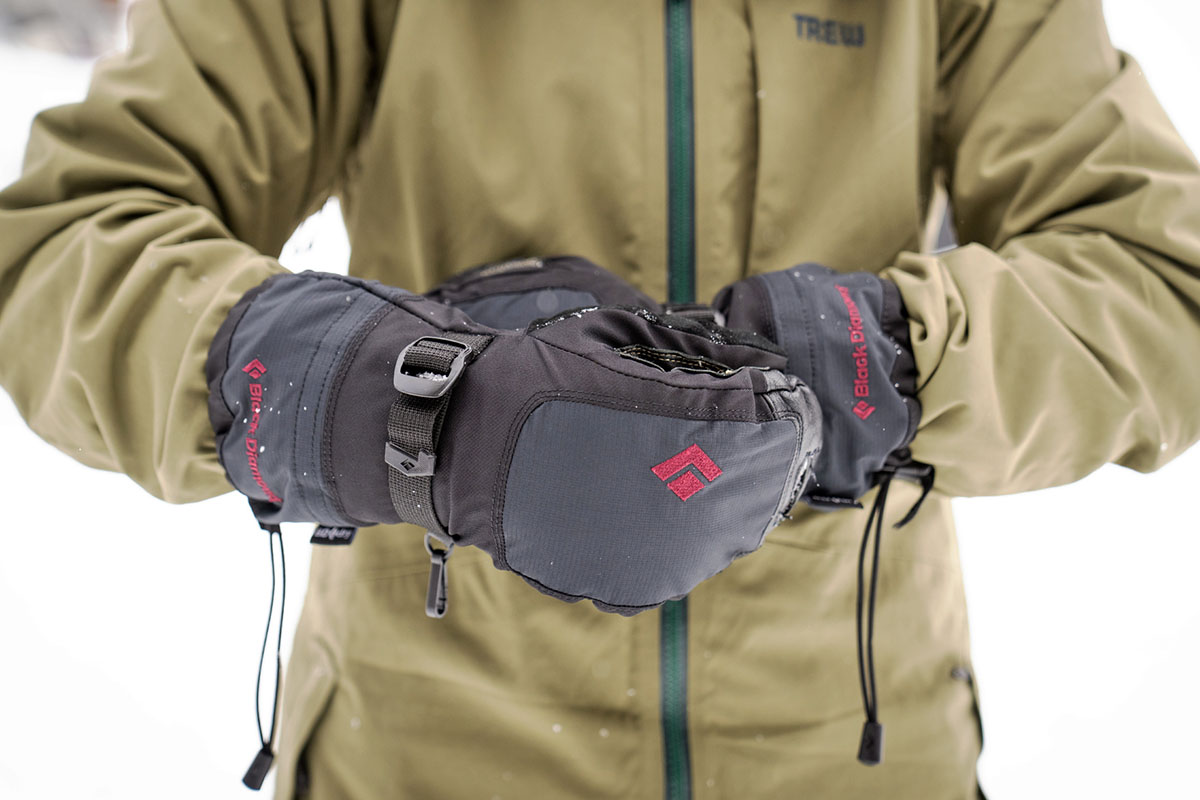
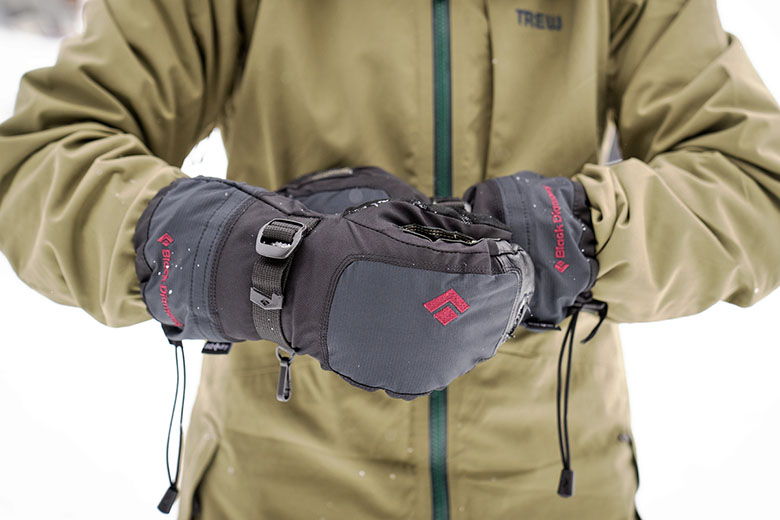
Switchback Travel (Jason Hummel)
Nothing spells cozy quite like a winter mitten, which by definition prioritizes warmth over dexterity. It’s true that you’ll most often catch us wearing gloves, but we do prefer mittens for particularly frigid environments and wind-generating activities like snowboarding, cross-country skiing, and bike commuting. Below we break down our top winter mittens for the 2024-2025 season, including leather work mitts, ski- and snowboard-specific designs, premium insulators for expedition use, and more. For more background information, see our winter mitten comparison table and buying advice below the picks.
Editor's note: We updated this guide on October 30, 2024, to move the Carhartt Waterproof Insulated Mitt up as our favorite budget pick. We also added details about our testing practices and swept the guide to ensure all information was current at the time of publishing.
 Category: Casual/performance
Category: Casual/performance
Shell: Polyester
Waterproof: No
What we like: Your favorite puffy jacket—for your hands.
What we don’t: Not particularly durable or water-resistant.
Patagonia’s Nano Puff Mitts might look fairly unassuming, but don’t be fooled: Just like the Nano Puff jacket (Patagonia’s best-selling jacket—ever), these mittens pack a serious punch. On the outside, you get a thin 20-denier polyester shell with durable water-repellent finish, while the inside features 60-gram PrimaLoft Gold Eco insulation and a cozy tricot liner that trap warmth with minimal bulk. Taken together, the Nano Puff Mitts are lightweight, super dextrous (for a mitten, at least), easy to get on and off thanks to a large pull tab, and just as versatile as your favorite puffy. Come winter, they’re our mitten of choice for daily use, cross-country skiing, backcountry ski touring, and more.
Of course, the Nano Puff Mitts can’t hold a candle to designs like the Black Diamond Mercury and Outdoor Research Alti II in terms of waterproofing, durability, and warmth. But what they do have going for them is a lightweight, dextrous build that traps a hefty dose of body heat you generate and grips ski poles, shovel handles, and steering wheels with ease. They’re right beside our door for short winter errands, always at the bottom of our pack for technical routes and ski tours, and easy to throw in an overnight kit for casual weekends, too. For everything from daily warmth to a lightweight and packable backcountry savior, the Nano Puff Mitt is our top pick.
See the Patagonia Nano Puff Mitts
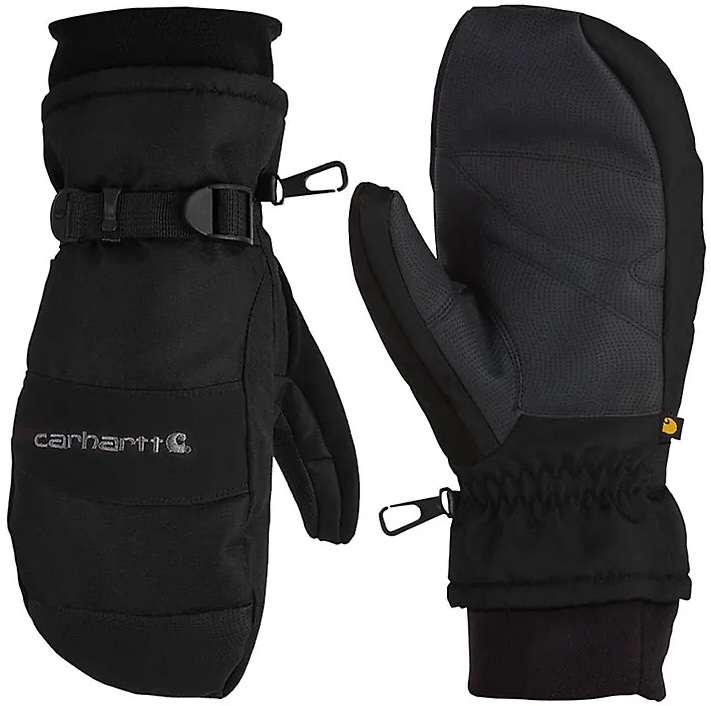 Category: Casual/work
Category: Casual/work
Shell: Polyester
Waterproof: Yes
What we like: A reasonably hardwearing waterproof and insulated mitten for just $27.
What we don’t: Unrefined fit and compromised breathability.
Not everyone wants to spend upwards of $100 (or more) on a winter mitten, nor do they need to. For a budget mitten that can get the job done for short outdoor chores, walks around the block, or the odd day at the ski area, check out the Carhartt Waterproof Insulated Mitt. Priced at just $27, the mitten keeps moisture out, is insulated for mildly cold temperatures (most hands will be cozy down to about 20 degrees Fahrenheit), and offers a nice set of performance features, including a wrist cinch, nose wipe, and soft and moisture-wicking fleece-lined interior. Carhartt is known for hardwearing gear that’s built to withstand real-world use, and their budget mitt is no exception.
What do you give up with a sub-$30 mitten like the Carhartt? Fit and dexterity certainly suffer: We’ve found that the Waterproof Insulated Mitt has a fair share of extra material around (and beyond) the fingers, which can make gripping objects a bit tricky. Waterproofing also falls short, which might not matter for temperatures well below freezing, although the main downside to the budget membrane is the lack of breathability—this is especially significant for high-output activities or those prone to sweaty hands. But for the price, the Carhartt Waterproof Insulated Mitt is nevertheless a superb value for every-so-often or emergency use. For an affordable leather design, check out the Flylow Oven Mitt ($55) below.
See the Carhartt Waterproof Insulated Mitt
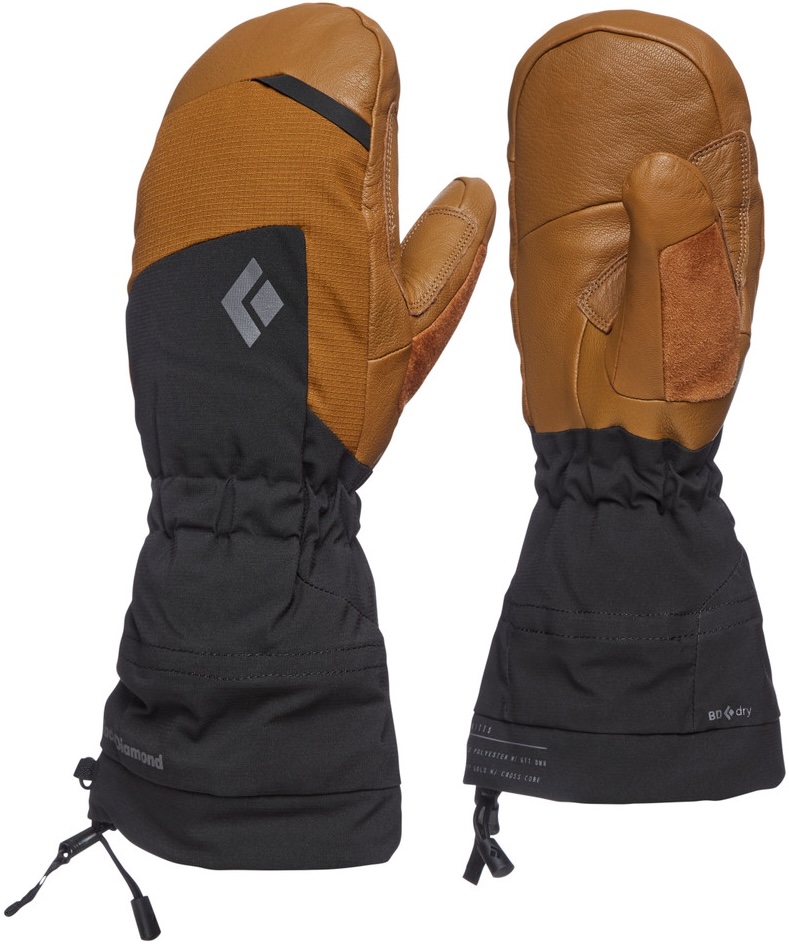 Category: Performance
Category: Performance
Shell: Synthetic/leather
Waterproof: Yes (BD.dry)
What we like: Proven warmth at a decently low cost.
What we don’t: Black Diamond’s in-house waterproofing isn’t as premium as Gore-Tex.
If winter gets cold in your neck of the woods—or if you venture into frigid temperatures by choice—check out Black Diamond’s Mercury Mitt. Designed to keep your hands warm in temperatures as low as -25 degrees Fahrenheit, the Mercury features a waterproof shell, generous gauntlet, and removable liner mitt, which is packed with PrimaLoft Gold insulation (340g) and lined with fleece for next-level coziness. And despite its bulk, the Mercury is decently dextrous (thanks to a four-way stretch shell, thinner insulation at the palm, and a nice grip between the insulation and liner) and designed to take a beating, too, whether you're handling ropes, snow shovels, or chairlifts.
The Mercury’s warmth will be sufficient for most who live and adventure in the Lower 48, and at just $120, the price is competitive, too. It's worth noting that the Mercury features BD’s in-house waterproof membrane rather than more premium and reliable Gore-Tex—but we’ve found the waterproofing to be fully sufficient for temperatures below freezing. If you’re looking for more insulation (say, for a trip to the Arctic, life in Alaska, or climbing in the greater ranges), Black Diamond also makes the Absolute Mitts ($270), which are rated to -40 degrees Fahrenheit. All told, there’s a lot to like about the Black Diamond Mercury, making it our mitten of choice for cold hands and cold climates alike.
Read more: Women's Black Diamond Mercury Mitt review
See the Men's BD Mercury Mitts See the Women's BD Mercury Mitts
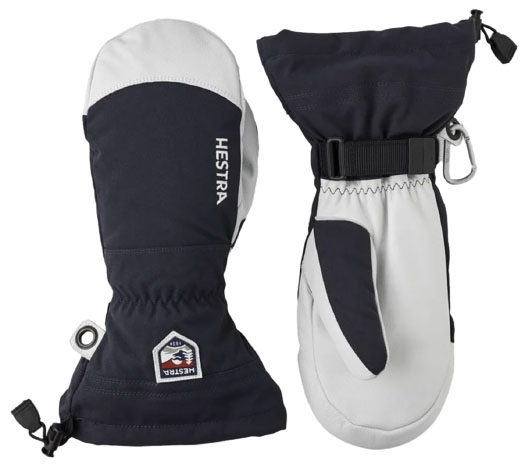 Category: Performance
Category: Performance
Shell: Polyamide/leather
Waterproof: No
What we like: A supple and soft ski glove with a premium fit and finish.
What we don’t: Expensive; requires care to maintain waterproofing.
For the best ski mitten, we turn to Sweden-based Hestra, a brand that’s spent almost a century defining the premium handwear market. The Heli is their most popular ski-specific model, and it’s the full package for us, too: The shell design combines a waterproof synthetic material on the back of the hand with a supple leather grip, while the removable liner features G-Loft synthetic fill and a soft fleece interior. And with sleek seams and no unnecessary materials, the Heli Mitt is just about as breathable and dextrous as can be without compromising on warmth and weather protection. In short, Hestra’s mitten exudes premium quality from tip to gauntlet and is an easy pick for our favorite ski-specific design this year.
We appreciate the Heli’s fairly simple feature set, which includes a Velcro wrist strap (a large buckle makes this easy to adjust with mittens on) and mid-length gauntlet with a one-handed cinch. Notably missing is a nose wipe, but the inner liner gets the job done in a pinch and is decently easy to free from (and reattach to) the outer mitt. But at $160 (or $150 for the women’s version), you’re definitely paying for the premium fit and finish. Also noteworthy: The leather does require aftermarket treatment to be fully waterproof—you’ll want to apply some of Hestra’s leather balm (or a similar Nikwax product) before you hit the slopes. Lastly, if you’re interested in a more snowboard-specific style, we love the Outdoor Research Mt. Baker II GTX, a fully waterproof mitten with a long gauntlet and removable glove liner.
See the Men's Hestra Army Leather Heli Mitt See the Women's Hestra Heli Mitt
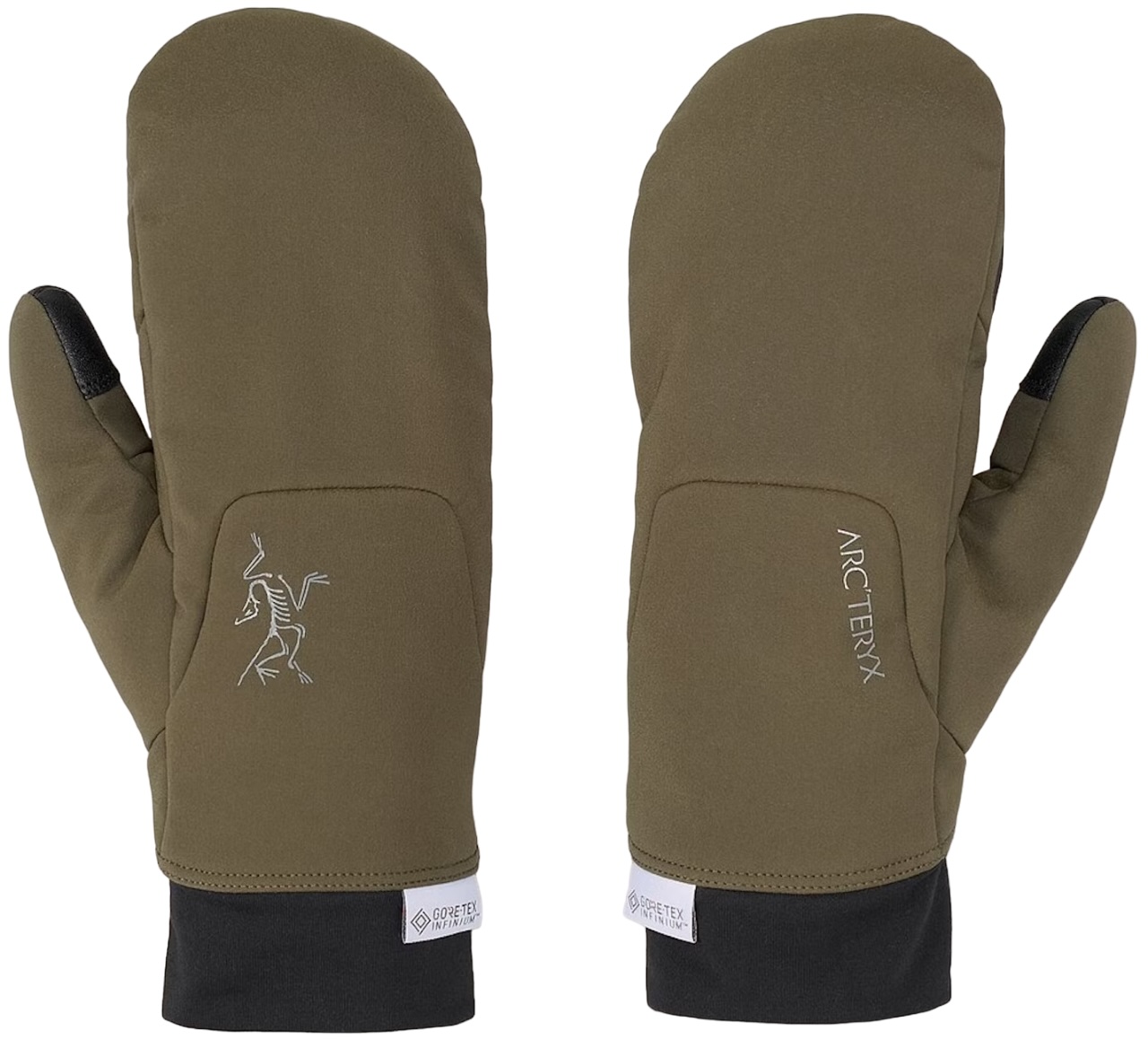 Category: Performance
Category: Performance
Shell: Softshell
Waterproof: No
What we like: A near-ideal mix of warmth, breathability, and windproofing for winter running and cross-country skiing.
What we don’t: Not warm enough for slower-paced activities in cold weather.
If your winter routine involves activities like cross-country skiing or running, you’ll want a mitten like the Arc’teryx Venta. The Venta features just enough insulation to cut the chill of a frosty morning (you get a light fleece at the front of the hand and warmer Octa Loft at the back), along with a breathable softshell face that dumps the heat that you’ll inevitably build. And while it’s not quite waterproof, the Gore-Tex Infinium shell is fully windproof and provides a reliable defense against most rain and snow. To top it off, the Venta offers excellent dexterity and grip (great for holding your ski pole), and the touchscreen patches actually work—a rarity among mittens.
We’ve worn a number of different gloves and mittens while winter running and cross-country skiing and generally have one of two gripes: Either our hands get cold, or they get clammy. The Venta mittens are truly the best solution we’ve found for this cold-weather conundrum. But they are a ‘tweener mitt: We often drop down to a liner glove as temperatures creep toward 40 degrees, and for lower-output activities (even hiking or snowshoeing) in sub-freezing conditions, you’ll certainly want more mitten. It’s also worth mentioning the Outdoor Research Deviator Mitts ($69), a similarly intentioned design that tacks on a goat leather palm. Note: The Venta isn't currently available, but Arc'teryx has informed us that they expect it to return.
See the Arc'teryx Venta Mitten
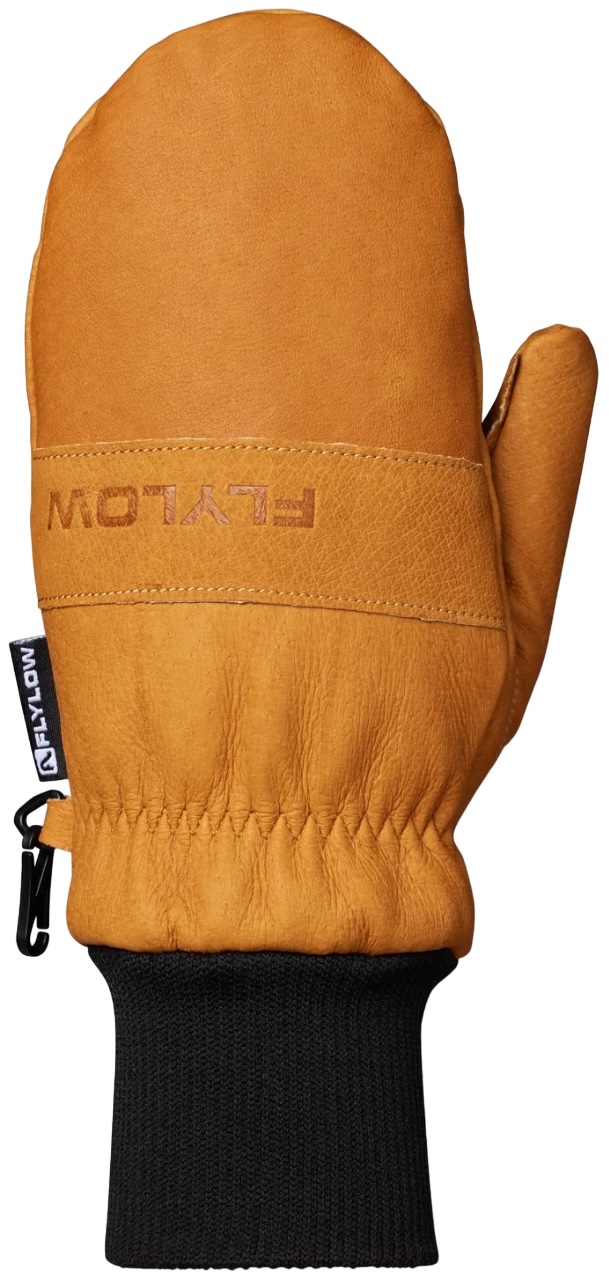 Category: Work
Category: Work
Shell: Leather
Waterproof: No (water-resistant)
What we like: An affordable and supple leather mitten.
What we don’t: No waterproof membrane means you’ll have to keep up with the leather treatment.
There are a lot of great insulated leather work mittens out there, but Flylow Gear’s Oven Mitt is by far our favorite. Like many modern leather designs, the Oven Mitt features a supple pigskin leather shell and soft polyester lining, with synthetic Greenloft fill placed in between (100g at the palm and 200g at the back of the hand). The Oven Mitt is also quick to break in, developing good dexterity after just a few wears (for comparison, they wear in noticeably quicker than the also-budget-friendly Kincos below). Finally, the $55 price tag is a steal of a deal, undercutting premium competitors like the Hestra Fall Line below by over $100.
The Oven Mitts are a consistent favorite among lifties, farmhands, and anyone else in need of a durable, grippy, and dextrous winter mitten. However, unlike prior versions, the latest Oven Mitt doesn't come pre-baked with Sno-Seal wax, resulting in a noticeable drop in wet-weather protection. To be fair, you still get a DWR finish for fending off light moisture, and it's easy to apply a waterproofing treatment on your own, but we nevertheless appreciated the time and cost savings (there's still some stock available of the past-season OG Baked Oven Mitt at the time of publishing). If you're looking for reliable waterproofing out of the box, Give'r offers a high-quality option in their Frontier below, but you’ll spend up for the brand cachet. Ultimately, the Oven Mitt is still a fantastic value, earning it a respectable finish on our list this season. A final note: Flylow’s sizing runs particularly small, so you’ll want to consider sizing up.
See the Flylow Gear Oven Mitt
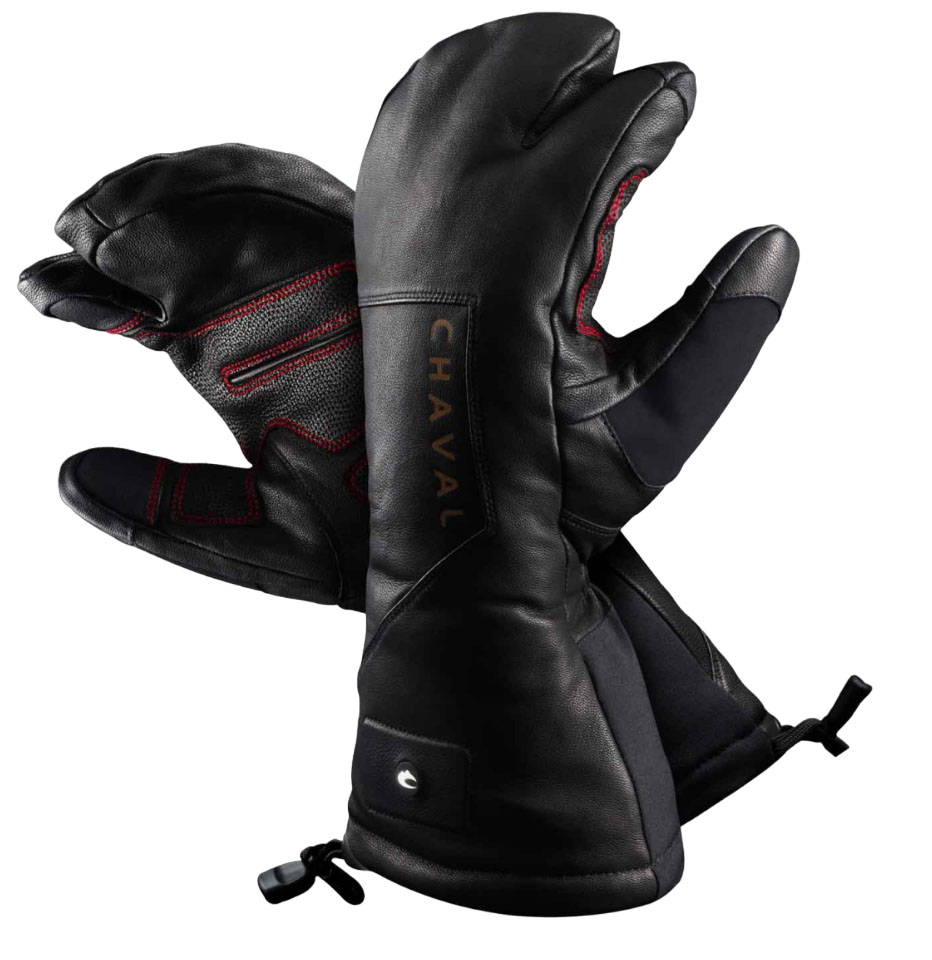 Category: Performance
Category: Performance
Shell: Leather
Waterproof: Yes
What we like: Serious warmth for those who suffer from cold hands; longer-lasting, warmer, and less bulky than competing heated mittens.
What we don’t: Expensive.
If you struggle with persistently cold hands or simply want to maximize warmth, a heated mitten can make a world of difference. While household names like Outdoor Research, Black Diamond, and Hestra all have a heated mitten in their lineup, far and away the best model we’ve tested is from a little brand called Chaval. Based on an island off the coast of Seattle, Chaval specializes in heated gloves and mittens, and their SuperNova Heated Mitt offers a premium feel and performance that you just don’t get from other brands. Chaval’s Alphaheat technology has climate control that responds to the temperature of your hands—no need to toggle it on or off, up or down—works in sub-zero (Fahrenheit) temperatures, and lasts for significantly longer than other brands (4 to 6 hrs compared to the OR Prevail’s 2.5 hrs on high, for example).
The SuperNova Mitts are also easy to recharge: Unlike other brands, they don’t require you to remove any batteries from the cuff—simply disengage the plug inside and insert it into the charger. They’re also a bit more dexterous than other heated mitts thanks to heating tech that uses a thin polymer film rather than wires, and the mitten has a handy half-trigger finger that’s surprisingly useful. Of course, the biggest impediment of a heated glove is cost, and at $425, the SuperNova Mitt is far and away the most expensive design to make our list. But if you’re sick of constantly churning through disposable handwarmers and want the best heated mitten money can buy, look no further than Chaval.
See the Chaval SuperNova Heated Mitt
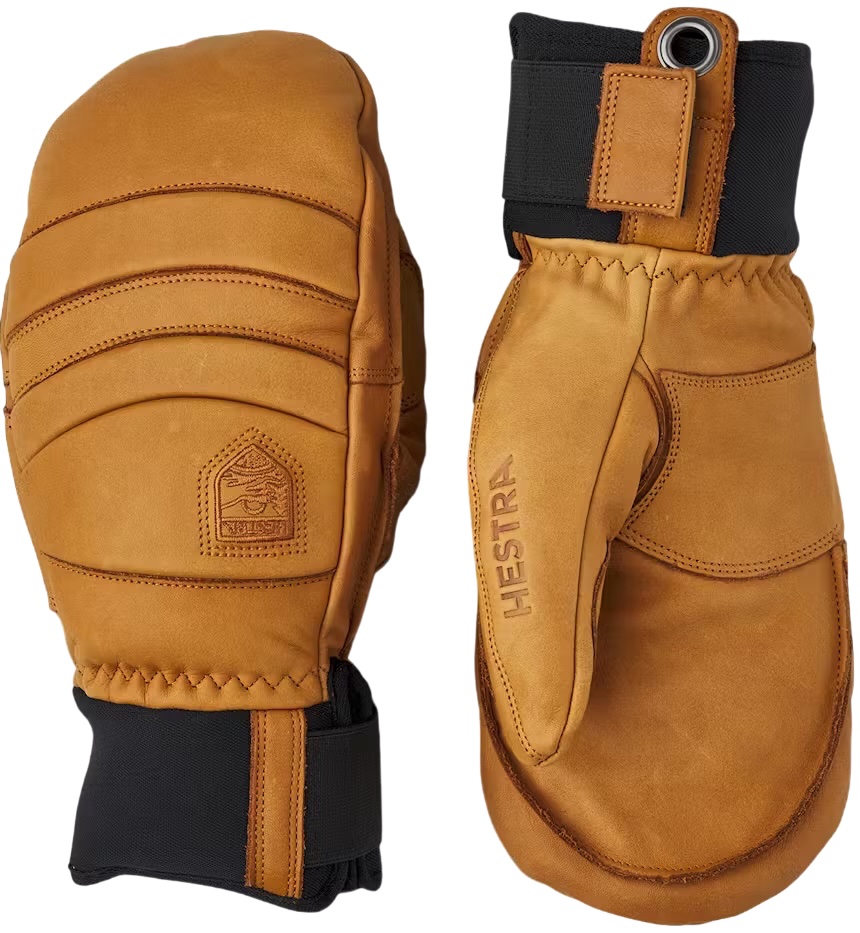 Category: Performance/casual
Category: Performance/casual
Shell: Leather
Waterproof: No (water-resistant)
What we like: Incredible build quality; great comfort and dexterity.
What we don’t: Expensive and not fully waterproof.
The Hestra Fall Line Mitt is a true work of art. This versatile leather design is equal parts ski mitten and everyday workhorse: It offers sufficient insulation and cushioning on the back of the hand for most winter sports (the glove version earned a spot on our list of the best ski gloves), but is dexterous enough to use while driving, shoveling snow, and simply walking around town. And the Fall Line is made to last—our well-worn pair has softened and conformed to our hand, giving it a custom feel that still performs like new (consistent maintenance has helped here).
We were tempted to rank the Fall Line in our number one spot—it’s just that supple, cozy, durable, and versatile—but many will find it difficult to justify the $165 price tag. And like most leather gloves (which also don’t include a built-in waterproof membrane), it does require routine treatments with a waterproofing wax or spray. Compared to the Flylow Oven Mitt above, the Hestra is noticeably warmer (the removable glove liner helps) and tacks on features like back-of-hand padding, a Velcro cuff adjustment, and a leash. It’s also over three times the investment. But for a classy leather mitten that’s at home both on the mountain and around town, the Fall Line may be worth it depending on your needs and priorities.
See the Men's Hestra Fall Line Mitt See the Women's Hestra Fall Line Mitt
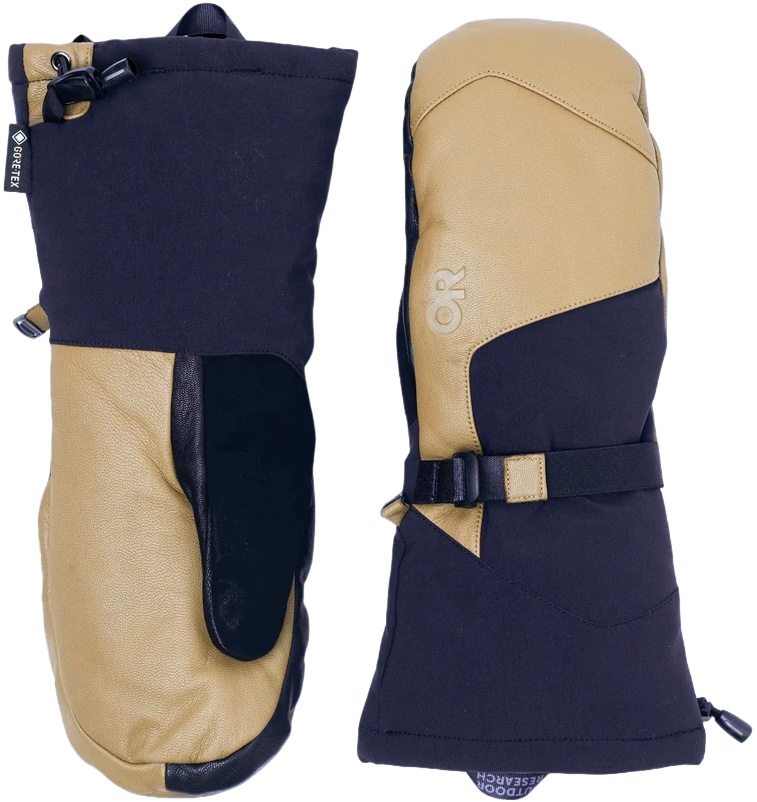 Category: Performance
Category: Performance
Shell: Synthetic/leather
Waterproof: Yes (Gore-Tex)
What we like: A warm, waterproof, dextrous, and durable ski mitten; more affordable than the competition.
What we don’t: No removable liner.
Seattle-based Outdoor Research is known for delivering thoughtful and premium designs at a lower price point than most, and their Carbide Sensor Mitts are a case in point. For just $130, the ski-oriented Carbide goes head to head with a mitten like the Hestra Heli above, from the premium leather grip to the waterproof membrane, generous gauntlet, and easy-to-toggle wrist cinch. And with 130-gram VerticalX Eco insulation on the palm and 200-gram at the back of the hand, these mittens are prepared for some serious cold. Just one issue: Although OR markets the Carbide as a touchscreen-compatible "Sensor" mitt, the technology will be fairly disappointing in a mitten of this bulk.
The key distinction between the Hestra Heli and the Carbide is the liner—while the former has a removable liner mitten, the latter’s is built in. We have a slight preference for removable liners: They’re quicker to dry between days on the slopes, and they can also be replaced, which can go a long way toward extending the lifespan of your mitten. On the flip side, they are a bit clunky (the Heli’s attaches via a strip of Velcro), can impact dexterity, and are just one more moving part to manage (or lose). And in the Carbide's favor, its waterproof membrane provides comprehensive protection, while the Heli's is only present on the back of the hand. All told, for $35 less than the Hestra, the OR certainly has a lot going for it.
See the OR Carbide Sensor Mitts
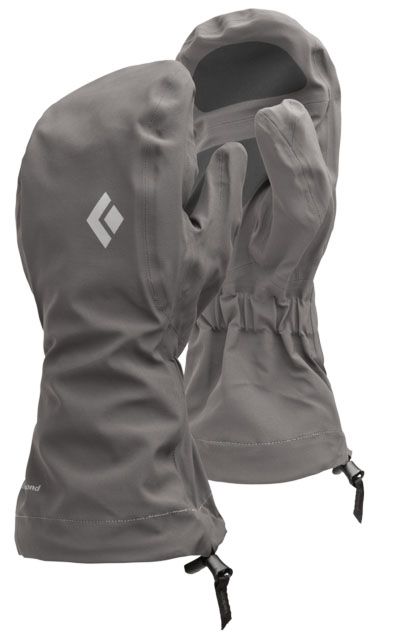 Category: Performance
Category: Performance
Shell: Synthetic
Waterproof: Yes
What we like: A versatile waterproof overmitt with endless applications.
What we don’t: Overbuilt for 3-season adventures.
It’s hard to beat the versatility of a waterproof overmitt, which easily slides right over the liner glove of your choice. And these little numbers pack quite the punch: They’re lightweight, packable, and offer complete water and wind protection. As a result, we love them for everything from bike commuting to backcountry skiing, winter hiking, and mountaineering—they might not be the most purpose-built design, but their applications are endless. Among similar options, Black Diamond’s Waterproof Overmitts are our top pick, with a stretchy 3-layer waterproof shell, long gauntlet, and textured palms for grip.
If you’re putting together a versatile handwear collection, the BD Waterproof Overmitts could be a key component: Pair them with a heavily insulated mitten for resort skiing, a sleek liner glove for snowshoeing, or just stash them at the bottom of your pack for emergency use. They’re admittedly not the lightest option—the High Tail Designs Rain Mitts is a more minimalist design for 3-season adventures but suffers in terms of breathability and lacks the protective gauntlet of the Black Diamond. If you’re looking for simple, winter-ready protection, BD’s overmitts are our top recommendation.
See the Black Diamond Waterproof Overmitts
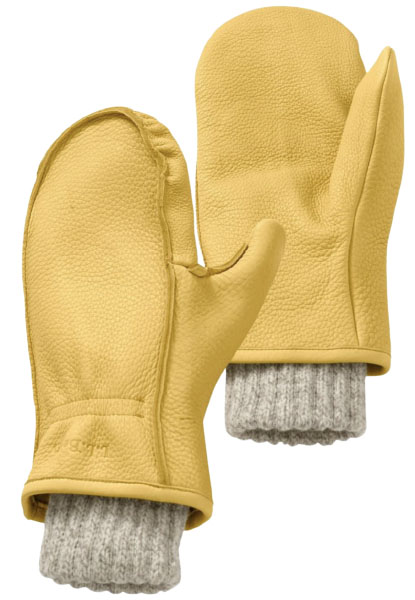 Category: Casual/work
Category: Casual/work
Shell: Leather
Waterproof: No (water-resistant)
What we like: Buckskin leather and wool—as classic as it gets.
What we don’t: Wool doesn’t dry quickly; you’ll have to waterproof them yourself.
Nothing spells classic quite like a leather chopper mitt, and the Buckskin Chopper from Maine-based L.L. Bean is as ageless as they come. On the exterior, wind-resistant deerskin leather is nicely constructed with exposed seams. On the inside, you get a removable and cozy merino liner built with an itch-free wool/nylon interior. For a mitten style, the Chopper also is reasonably dexterous: The mitten is supple out of the box and flexes quite a bit to provide decent grip around a shovel or hand rail.
What are the downsides of the L.L. Bean Chopper Mitts? Unlike the Give’r Frontier below, they do not have a waterproof membrane, and therefore the leather requires a wax or DWR treatment to keep moisture out. And while wool continues to insulate when wet, it does have a tendency to absorb a lot of water and is slow to dry. But for casual use, the Chopper Mitt is a classy mitten that’s made to last—there’s even an extra “wing” of buckskin on the crook between the thumb and index finger for durability. For a traditional look around town or outdoor chores around the home, the Buckskin Chopper is a great option for cold and dry conditions.
See the L.L. Bean Buckskin Chopper Mitt
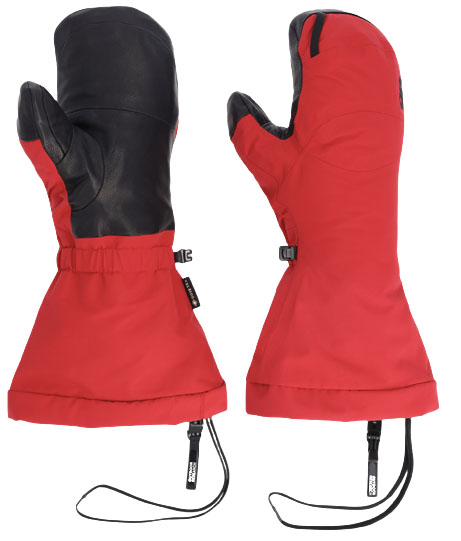 Category: Performance
Category: Performance
Shell: Nylon/leather
Waterproof: Yes (Gore-Tex)
What we like: Premium warmth and waterproofing for the world’s worst weather.
What we don’t: Expensive; heavy insulation results in limited range of movement.
If Black Diamond’s Mercury Mitt (above) caught your eye, it’s also worth checking out the Outdoor Research Alti II. Touted as an expedition mitten for high mountain environments, this is performance design through and through. And for many conditions it’s a great 3-in-1 combo: You get a burly nylon shell with a Gore-Tex membrane and insulation, along with an easily removable PrimaLoft-insulated liner mitt. Wear the two together in the coldest temps, or either component on its own depending on activity level and conditions. And the mitt comes with a number of features ideal for technical endeavors, including a removable leash, durable leather palm, and extended gauntlet design.
If you’re predominantly adventuring in the Lower 48, you’ll want to think twice before opting for the Alti. The heavy insulation and removable liner have a noticeable impact on fine motor movements (we can’t grip a ski pole securely with them), and the warmth is overkill for high-output activities. What’s more, $209 is a solid investment, especially given that options like the Black Diamond Mercury Mitt above ($120) or OR’s lighter-weight Mt. Baker II Gore-Tex Mitts ($179) will get the job done for most. But for uncompromised warmth for winter camping or expeditions in the greater ranges, the Alti is truly hard to beat.
See the Men's OR Alti II GTX Mitts See the Women's OR Alti II GTX Mitts
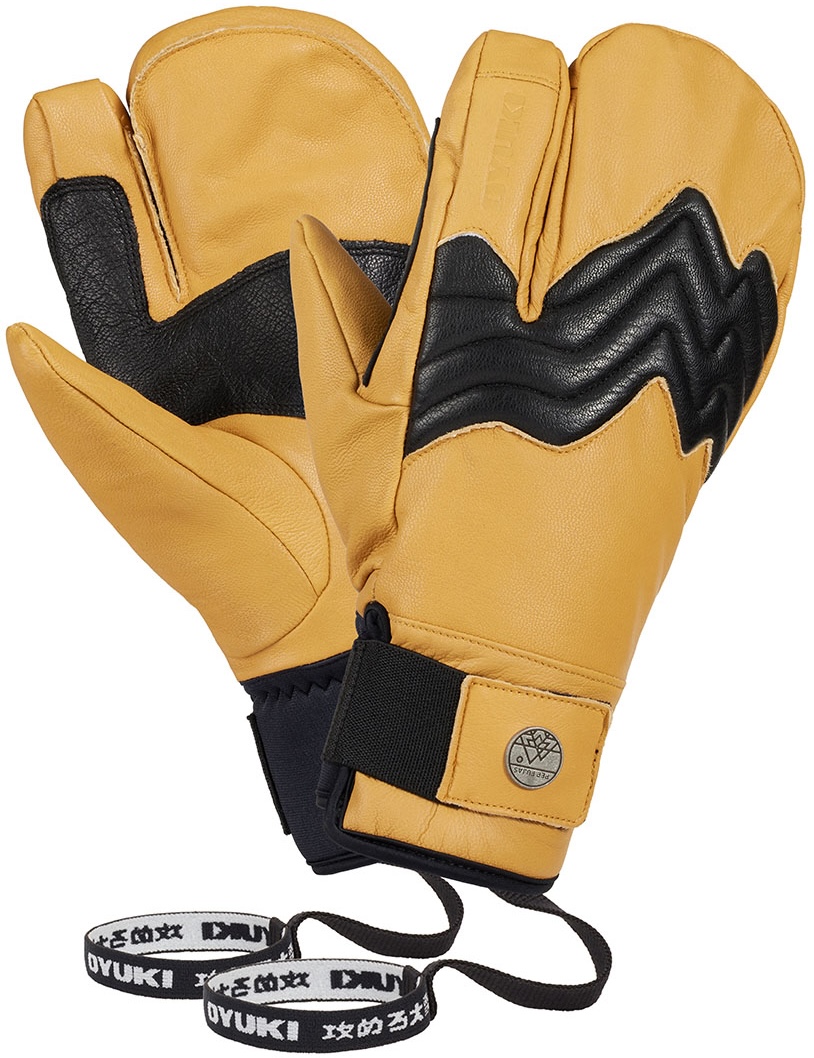 Category: Performance
Category: Performance
Shell: Leather
Waterproof: Yes (Gore-Tex)
What we like: Premium build and excellent dexterity.
What we don’t: Split-finger design can’t match the warmth of a mitten.
If you’re on the fence between a glove and a mitten, it’s worth looking into a trigger mitt (also known as a three-finger mitt or lobster mitt). On paper, this concept is the best of both worlds: By combining a mitten with a dedicated slot for your pointer finger, you get more thermal efficiency than a standard glove while retaining enough dexterity to pinch a zipper, fiddle with your bindings, or even send a text. Downsides are that your pointer finger ends up being just as cold as it would be in a glove, and freedom of movement still falls short of a regular five-finger design. But trigger mitts nevertheless provide a nice middle ground of warmth and dexterity, and we think Oyuki’s Pep pulls it off better than most.
We snagged a pair of the Pep Trigger Mitts a couple winters back—our tester's first experience with the three-finger design—and were immediate converts. Built out of premium goatskin leather, the Oyuki only gets better with age, and the undercuff design is sleek yet secure with a wide hook-and-loop cinch. There’s a lot going on under the hood, too: The Pep comes with high-quality touches like a Gore-Tex waterproof insert, warm PrimaLoft insulation (200g on the back of hand and 133g on the palm), and a soft fleece lining. If you’re curious about the trigger design—or are in the market for a premium ski or snowboard mitt—the Pep is a solid option.
See the Men's Oyuki Pep GTX Trigger See the Women's Oyuki Chika GTX Trigger
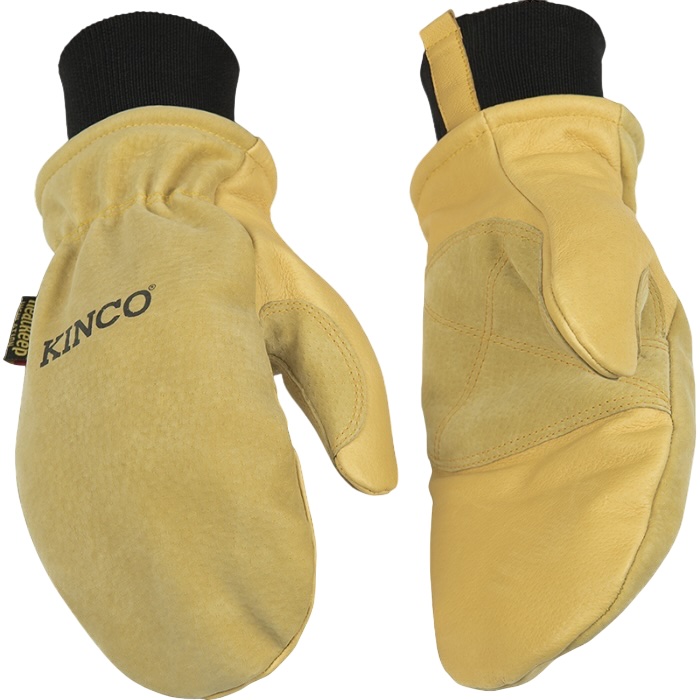 Category: Work
Category: Work
Shell: Leather
Waterproof: No (water-resistant)
What we like: Trusted performance and great durability at a low price.
What we don’t: Limited warmth and difficult to break in.
Kinco started the leather snow glove craze in the 1980s, and this wouldn't be a proper list without including them here. To follow in a long line of ski bums and resort employees, simply plunk down the 50 or so bucks these mittens are selling for at press time (you can often save a few bucks on Amazon) and buy some wax to condition the leather and make them more water-resistant (a few sample packets of Nikwax are included with purchase). The end result: a warm, durable, and comfortable mitten that will last you at least a season’s worth of hard use.
You won't find a more economical mitten (especially given the Kinco’s tough build), and this system works surprisingly well if the conditions aren't too cold or wet. It’s worth noting that these mittens do take a while to break in, and you’ll likely want to step up to a more waterproof design (with built-in waterproof membrane) for wet areas like the Pacific Northwest. But thanks to their bargain prices and proven performance and durability, Kinco gloves and mittens have reached legendary status in the work and resort worlds. For even more savings, check out the 1927KWT mitten, which features canvas along the back of the hand for improved breathability.
See the Kinco Lined Heavy-Duty Ski Mitt
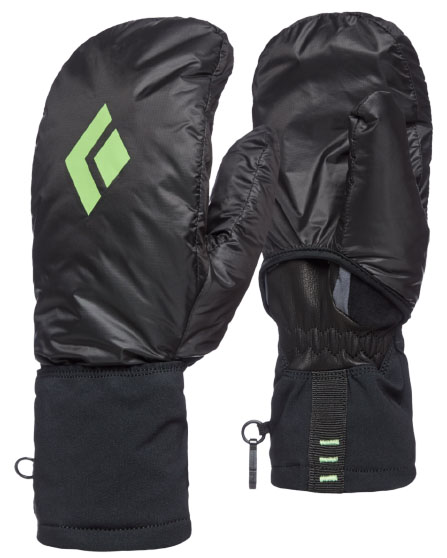 Category: Performance
Category: Performance
Shell: Synthetic/leather
Waterproof: No (water-resistant)
What we like: Breathability and dexterity for the climb; lightweight warmth and wind protection for the descent.
What we don’t: Very ski-specific.
We’re big fans of the hybrid glove/mitten concept, which gives you the breathability and dexterity of a glove alongside the warmth and wind-blocking protection of a mitten (we’ve also heard this design referred to as a “glommit,” which makes us love it even more). Purpose-built for backcountry skiing, the Black Diamond Cirque has become a staple in our winter and spring lineup. The Cirque pairs a capable yet lightweight ski glove, complete with reliable DWR finish and leather palm, with a lightly insulated and windproof “hood” that stows away neatly in the cuff when not in use. The effect is immediate when donning the hood—a true illustration of the power of shared body heat.
We especially love hybrid gloves/mittens for high-output activities, such as ski touring, winter running, and cold-weather biking. The hood comes off when you’re working hard on the uphill, but packs some serious punch once you start descending. And the Cirque is particularly well executed—Black Diamond used windproof and very water-resistant Pertex Quantum Pro for the hood, and packed it with lightweight PrimaLoft Gold. Added up, it’s our favorite hybrid design, although its ski-specific feature set doesn’t lend too much versatility. For a less insulated option (more ideal for winter running), check out the Smartwool Active Fleece Wind Mittens.
See the Black Diamond Cirque Gloves
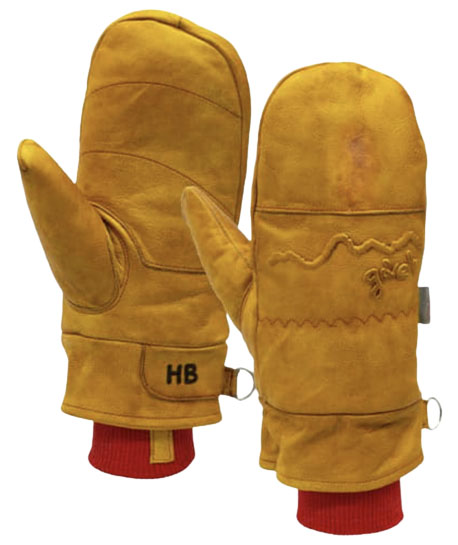 Category: Work/performance
Category: Work/performance
Shell: Leather
Waterproof: Yes
What we like: A premium leather mitt with waterproof membrane and fun styling.
What we don’t: Expensive and overkill for most outdoor work.
Give’r might not offer the same breadth of products as brands like Black Diamond and Outdoor Research, but this small Jackson, Wyoming-based company makes one heckuva leather glove (and mitten). Their boutique handwear is a step up from your standard work glove, with distinctive styling—the Teton styline (or approximation of) is sketched across every model—premium materials and construction, and the option to brand your initials onto the cuff. Of their two mittens, the Frontier is the premium option: In addition to a wax-treated leather shell, it incorporates a waterproof membrane for full-on defense against moisture. And the mitten packs in some serious insulation, with 380-gram Thinsulate at the palm and 490-gram Thinsulate at the back of the hand.
It’s hard to find fault with the Frontier’s styling and materials set, but in practice, it hasn’t earned a spot in our repertoire. Although technically a leather mitten, it feels more akin to performance offerings like the OR Carbide or Hestra Heli. In other words, it’s a bit too clunky for a work mitt (it’s significantly less dextrous than the Oven Mitt and Fall Line above), is much too warm and lacks breathability for high-output activity, and even has a crinkly feel due to the waterproof membrane. All told, the Frontier is too much mitten for outdoor chores like chopping wood or shoveling snow, but for resort or backcountry skiers who like the leather mitt vibe but need the added performance, we certainly understand the appeal.
See the Give'r Frontier Mittens
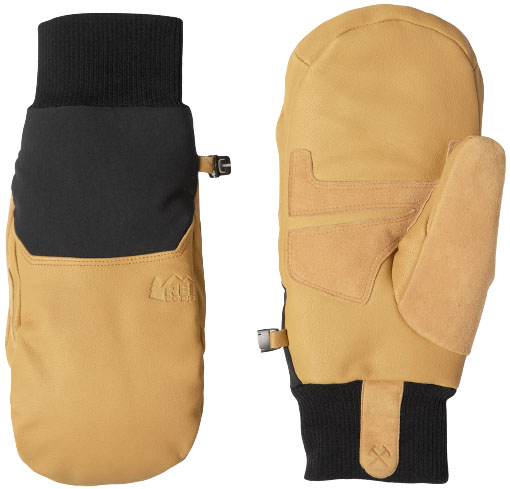 Category: Performance/work
Category: Performance/work
Shell: Leather/softshell
Waterproof: No (water-resistant)
What we like: Work glove looks with useful performance touches.
What we don’t: Not waterproof or very warm.
REI’s in-house line is a great one-stop shop for value, and we like what they’ve come up with in the Guide Insulated. Available in both a glove and a mitten, you get a mostly leather design that mixes the looks of a traditional work mitten with techy details like a softshell material on the back of the hand. The unisex model is offered in a range of sizes (from XS to XL), provides moderate insulation with a combination of synthetic fill and a fleece lining, and includes nice touches like a suede nose wipe on the thumb. For a very reasonable $50, the Guide Insulated offers a whole lot.
How does the REI Guide Insulated stack up to the Flylow Oven Mitt above? Both have durable leather palms and good dexterity for anything from chopping wood to backcountry skiing, although the Flylow is a bit tougher and more protective with its full leather build. On the other hand, the softshell material on the REI helps keep you comfortable when working up a sweat. Keep in mind that neither design includes a waterproof membrane (you’ll have to bump up to the Give’r for that), but that bit of added tech is unnecessary for cold and dry conditions. In the end, we give the edge to the more proven Flylow, but the Co-op’s Guide Insulated is nevertheless a worthy addition to any mitten quiver.
See the REI Co-op Guide Insulated
| Winter Mitten | Price | Shell | Insulation | Waterproof | Removable Liner |
|---|---|---|---|---|---|
| Patagonia Nano Puff Mitts | $79 | Polyester | Synthetic (60g) | No | No |
| Carhartt Waterproof Mitt | $27 | Polyester | Synthetic | Yes | No |
| Black Diamond Mercury Mitts | $120 | Synthetic/leather | Synthetic (340g) | Yes (BD.dry) | Yes (mitten) |
| Hestra Army Leather Heli Mitt | $160 | Polyamide/leather | Synthetic | No | Yes (mitten) |
| Arc’teryx Venta Mitten | $60 | Softshell | Synthetic | No | No |
| Flylow Gear Oven Mitt | $55 | Leather | Synthetic (200g & 100g) | No | No |
| Chaval SuperNova Heated Mitt | $425 | Leather | Synthetic | Yes | No |
| Hestra Fall Line Mitt | $165 | Leather | Synthetic & foam | No | Yes (glove) |
| OR Carbide Sensor | $130 | Synthetic/leather | Synthetic (200g & 130g) | Yes (GTX) | No |
| BD Waterproof Overmitts | $90 | Synthetic | N/A | Yes | No |
| L.L. Bean Buckskin Chopper | $79 | Leather | Wool | No | Yes (mitten) |
| OR Alti II GTX Mitts | $209 | Nylon/leather | Synthetic (170g & 340g) | Yes (GTX) | Yes (mitten) |
| Oyuki Pep GTX Trigger Mitt | $170 | Leather | Synthetic (200g & 133g) | Yes (GTX) | No |
| Kinco Lined Heavy-Duty Mitt | $53 | Leather | Synthetic | No | No |
| Black Diamond Cirque Gloves | $80 | Synthetic/leather | Synthetic (40g) | No | No |
| Give’r Frontier Mittens | $139 | Leather | Synthetic (490g & 380g) | Yes | No |
| REI Co-op Guide Insulated | $55 | Leather/softshell | Synthetic & fleece | No | No |
No matter how you choose to get outside in the winter—be it hitting the ski slopes or embarking on a frosty hike—keeping your hands comfortable and protected in freezing temperatures is a must. Many staff members at Switchback Travel call cold climates home, making a quality pair of mittens or gloves a key part of our cold-weather kit. Washington-based former senior editor Jenny Abegg kicked off this guide in 2023 with 15 of her favorite mittens. A year-round backcountry enthusiast who isn't deterred by plummeting temps and falling snow, Jenny is acutely aware of risks like frostbite and hypothermia and does everything she can to maximize heat retention. Editor Maddie Downie currently manages the guide. Also based in the Pacific Northwest, Maddie is an avid backcountry skier and spends a considerable amount of time romping around the North Cascades, giving her a keen eye for winter-ready warmth, solid waterproofing, and high-quality materials and components that hold up well to rough use.
In pinpointing our 17 favorite mittens this season, we relied primarily on firsthand experiences in the field. We've tested countless gloves and mittens over the years, taking them on chilly hikes, powder days at the ski resort and in the backcountry, and even ice climbing in Canada. In gauging performance, we pay close attention to how well each mitten fends off precipitation and wind, the degree to which it keeps our hands warm (and for how long) in varying temperatures, and how quickly we overheat during high-output uses like skinning and cross-country skiing. Although inherently less dextrous than gloves, we also ensure each mitten that makes our list offers enough mobility to grip ski poles, tweak boots and bindings, etc. As the market evolves, we'll continue updating our list above to reflect our current favorites.
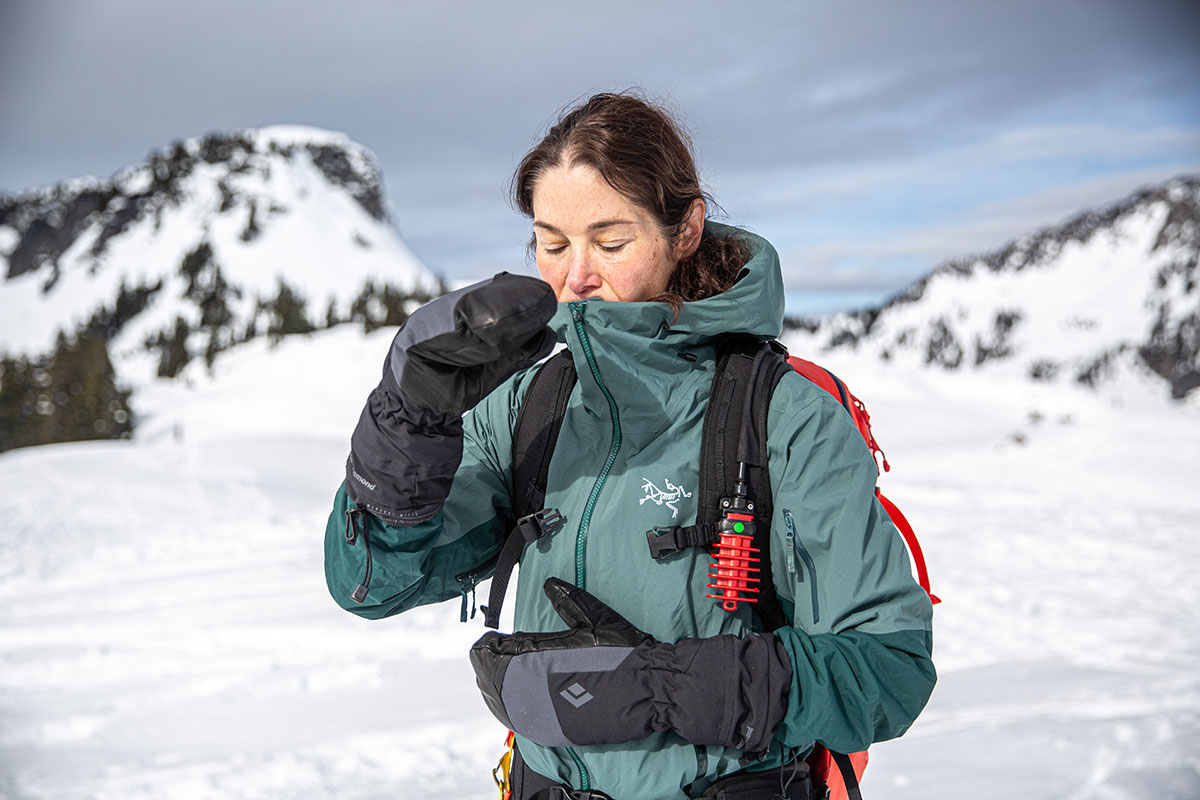
For the chilliest of conditions or those who suffer from habitually cold hands, mittens are a great choice. By keeping the fingers together rather than isolating them as gloves do, mittens offer a notable increase in protection and warmth. Throughout our time outside in cold conditions, we’ve noticed that mittens are especially ideal for wind-generating activities or sports that put your hands out in front of your body, such as biking, nordic skiing, and resort skiing. Of course, the largest downside to mittens is their lack of dexterity: Depending on the activity, you may end up removing them enough times that your hands would have stayed warmer in gloves (if you prefer this style, check out our article on the best winter gloves). But for the occasions when you don’t need nimble hands, nothing beats the warmth of mittens.
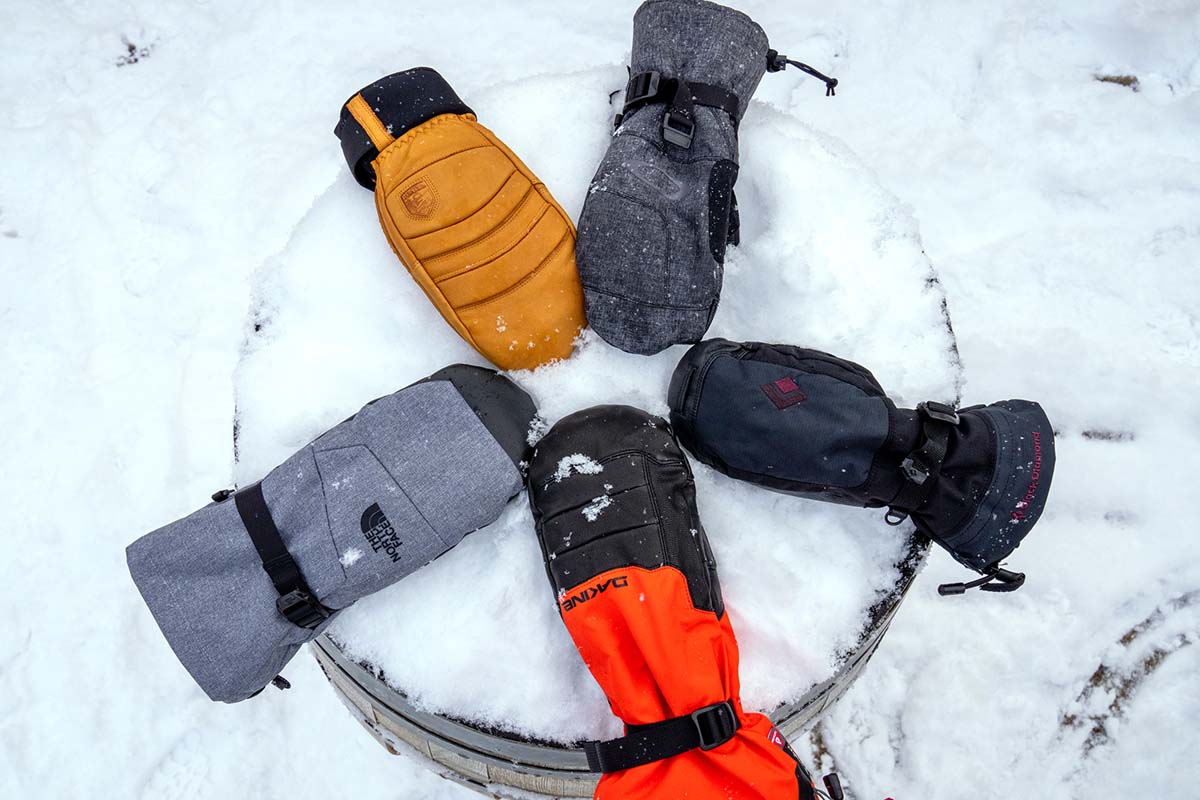
Performance
Performance mittens are designed for sustained use in demanding winter conditions, and are the best tool for the job for activities like mountaineering, skiing and snowboarding, nordic skiing, and winter bike commuting. Obviously, mittens made for high-output activities such as cross-country skiing will have vastly different traits than an arctic expedition mitt, so this is a wide category. But consistent features include wind and waterproof materials, quality insulation, good dexterity (as good as it gets with a mitten), grippy palms, snug-fitting cuffs, and often expensive price tags. Leading options include the Black Diamond Mercury Mitts, Hestra Army Leather Heli, and Arc'teryx Venta.
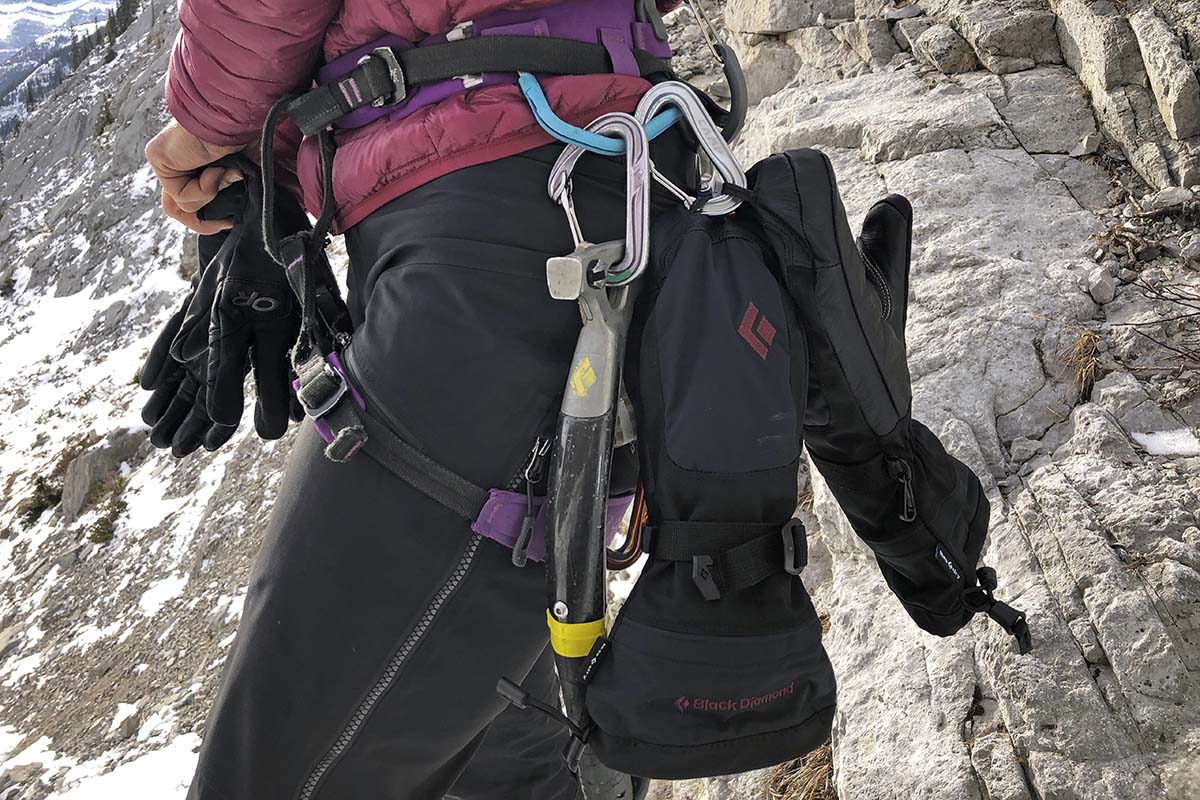
Casual
Casual mittens are our top picks for day-to-day activities such as walking the dog, driving to work, or short winter hikes. Some of these mittens are designed with full functionality in mind, while others prioritize styling and warmth. All casual mitts are made to keep your hands protected for brief periods of time in the cold, but many won’t stand up well to precipitation. In this category, look for undercuff designs, reinforced palms, and cozy wool or plush synthetic materials. Because they’re not intended for high-end performance, casual mittens are typically among the most affordable.
Work
Mittens in our work category put a premium on durability. For uses like chopping wood or operating a ski lift, a tough leather mitten is hard to beat—it’s no coincidence all our work mittens above are made primarily with leather. Look also for simple feature sets, reinforced palms, and short, undercuff designs. Most winter-ready work mittens are fleece-lined or synthetically insulated for added warmth, but you can always double up with a liner (at the cost of some dexterity).
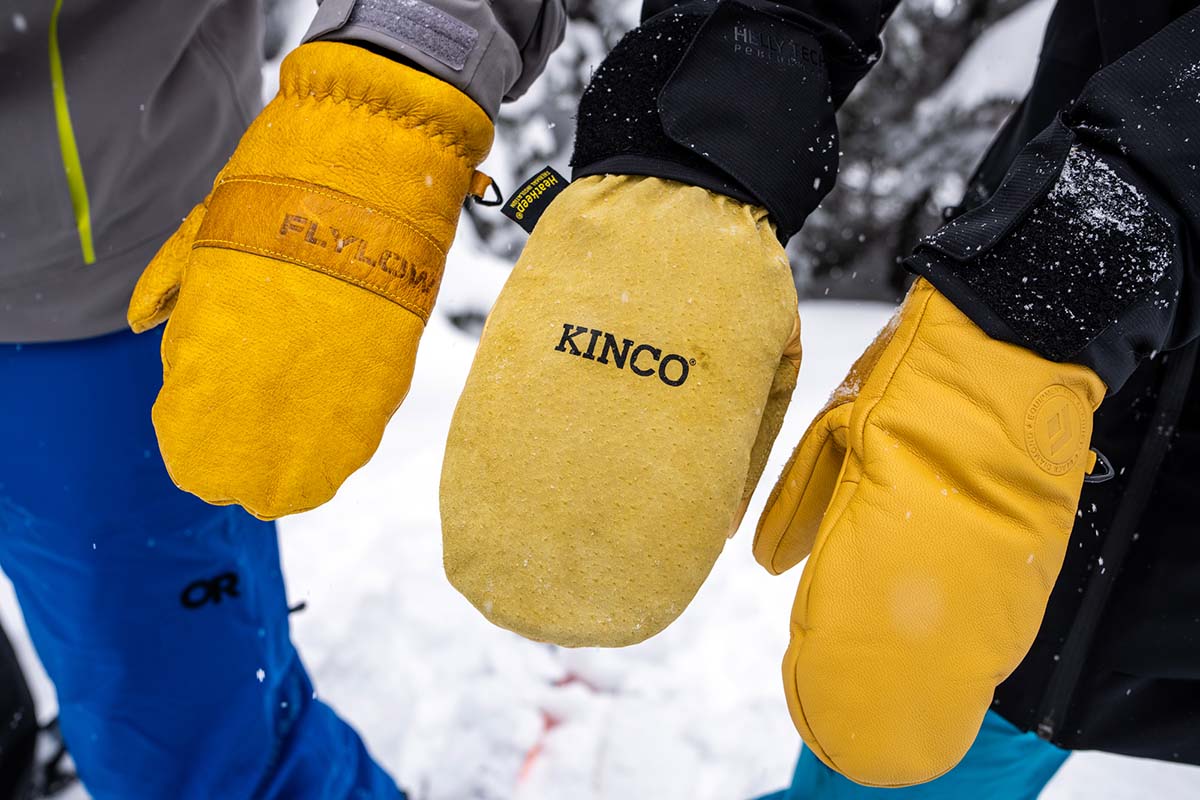
In general, work mittens are not made for extremely cold and nasty conditions, although there are some notable exceptions. The Give’r Frontier, for example, crosses over into the performance category with a well-insulated design (490g synthetic at the back of the hand) that balances weather protection, durability, and warmth. We know many winter enthusiasts who routinely wear models such as these for skiing and snowboarding rather than performance-oriented mittens like the Black Diamond Mercury or Hestra Heli. But take note: Although work mittens have their appeal, they lack the long, sealable gauntlet of many performance synthetic mittens, which does result in some compromised weather protection.
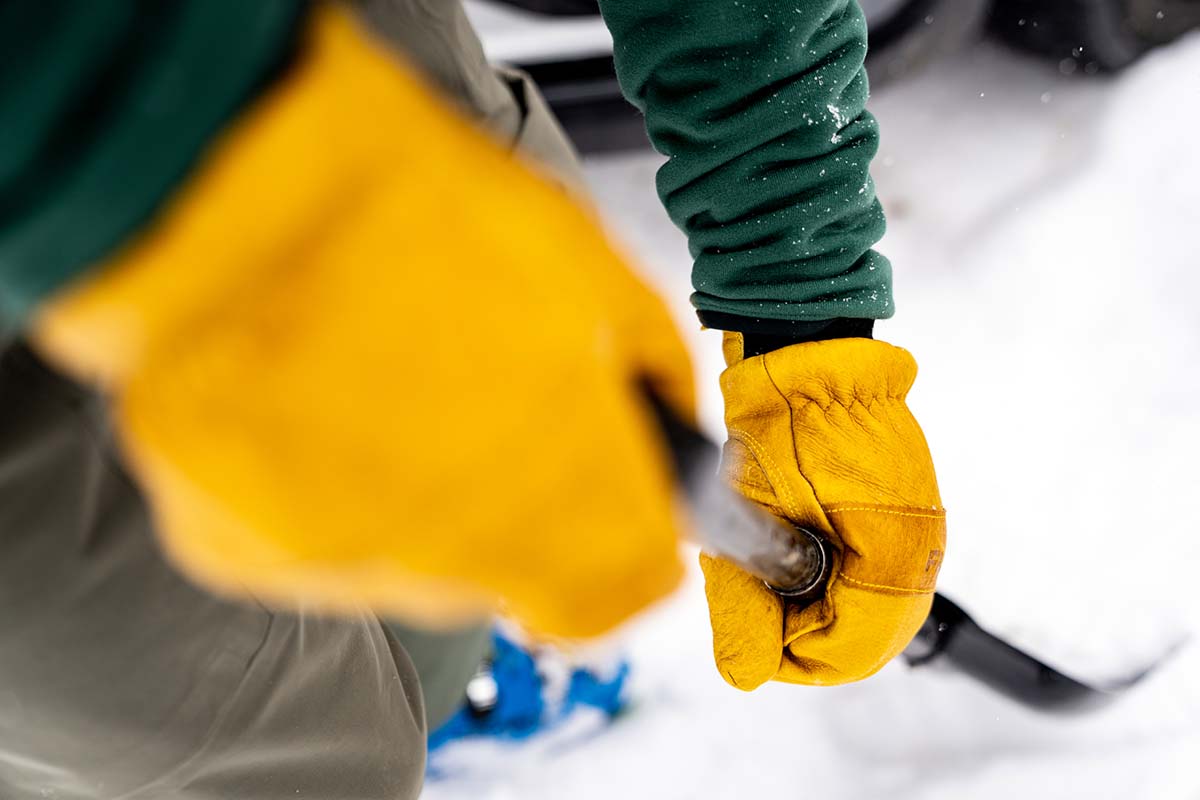
Warmth is a defining feature of a winter mitten, yet the amount of insulation provided varies widely between styles. On the very warm end of the spectrum are the Outdoor Research Alti II GTX and Black Diamond Mercury Mitts, which have thick synthetic fill, insulated liner gloves, and wind- and waterproof shells for keeping you protected in extreme conditions. On the other end is an uninsulated overmitt like the Black Diamond Waterproof Overmitts, which offer warmth only by trapping your body heat and keeping out wind and water. Many designs fall in between, like the Flylow Gear Oven Mitt: The premium leather build is dexterous for daily use, while the moderate level of insulation has kept us comfortable on mild-weather ski days and while shoveling snow. In the end, your ideal level of warmth will depend on the temperature and conditions, level of activity, and whether you’re prone to running hot or cold.
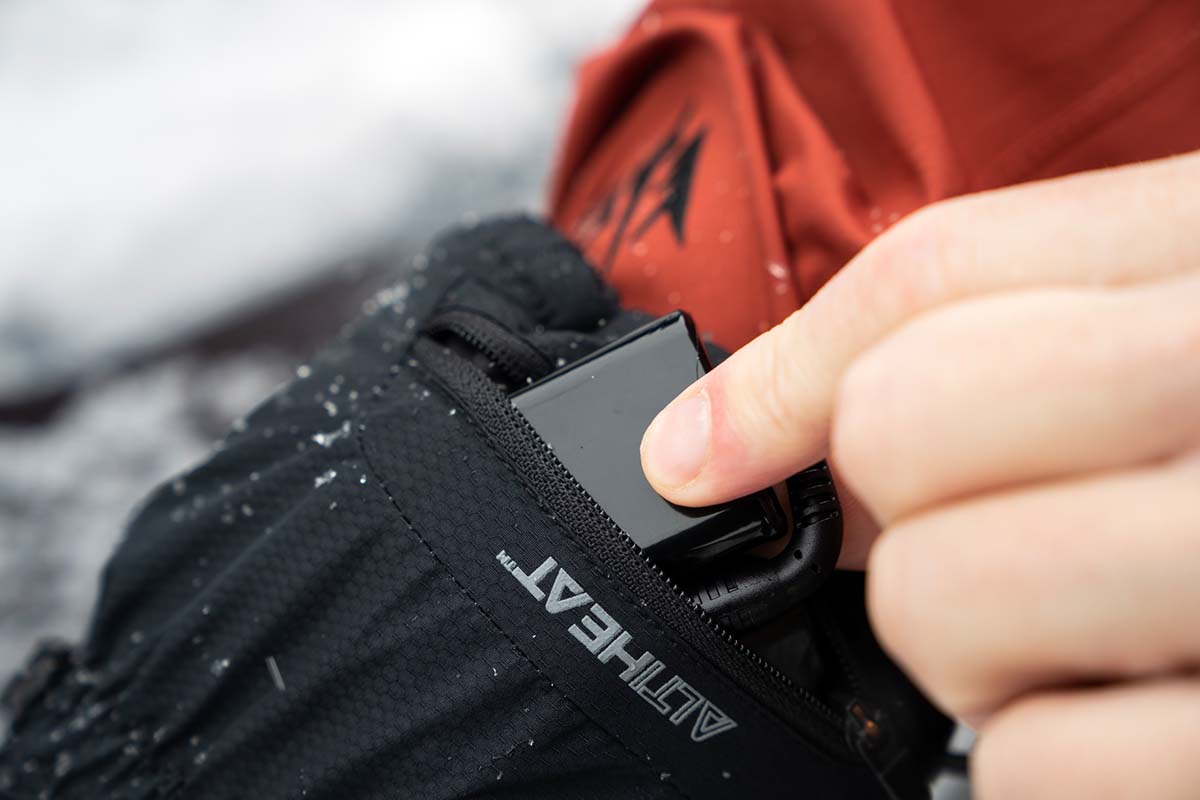
Synthetic
For a seriously warm mitten, synthetic fill is our preferred form of insulation. It has all the right properties: It insulates when wet, is a lightweight yet effective insulator, is reasonably durable and resists packing out, and is cheaper than down. As a result, all of the top performance mitts on our list use synthetic insulation, including the Outdoor Research Carbide Sensor and Alti II. It’s worth noting that the quality of the synthetic fibers is important—mittens that use name-brand fill such as PrimaLoft and Thinsulate are warmer for their weight and longer lasting than cheaper options that use generic polyester fill. That said, the amount of insulation (measured in g/m2) is still a decent indicator of warmth, and we’ve included the listed total for each mitten—if the manufacturer provides the spec—in the table above.
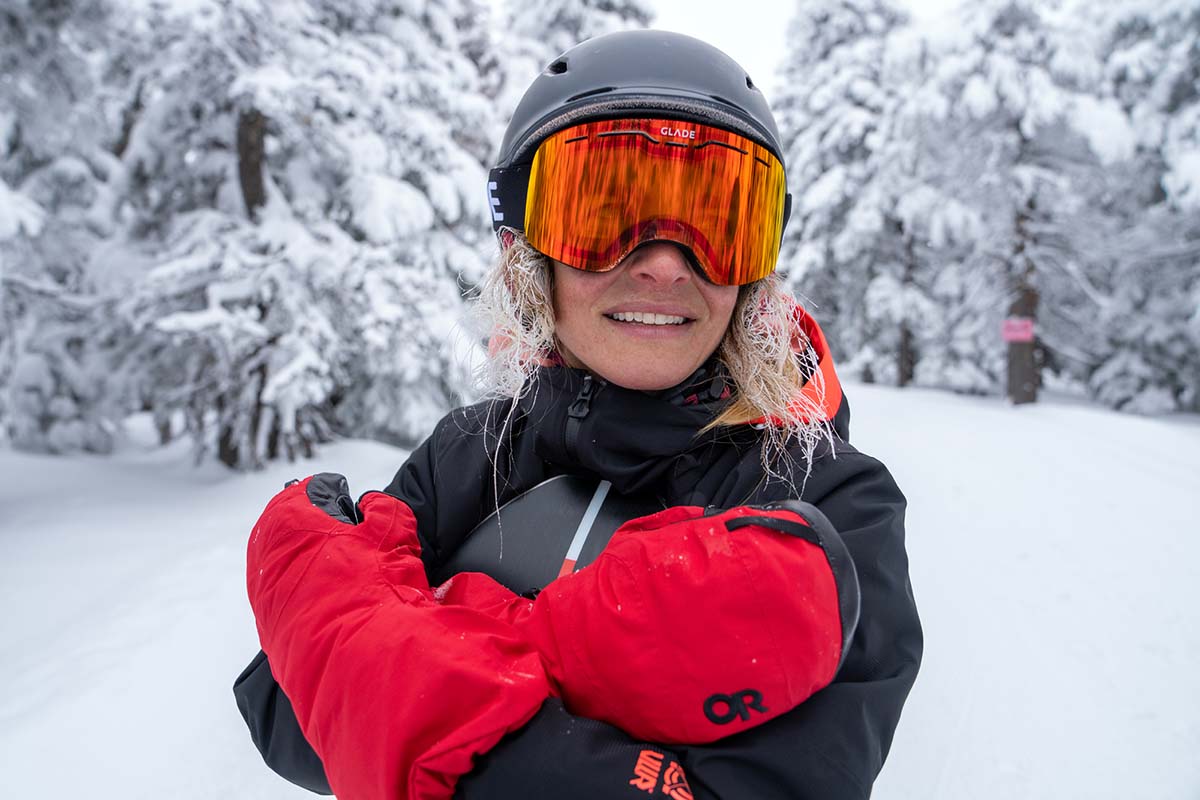
Fleece
Synthetically insulated mittens may dominate the performance category, but fleece is a popular insulator as well. Often used as the next-to-skin layer or in the liner, fleece is cozy, heat-trapping yet still breathable, and generally more affordable than synthetic fill. But because fleece doesn’t pack in quite as much warmth for the weight and bulk as synthetic fill, it’s generally used in addition to synthetic insulation, not as a replacement; for example, both the Hestra Army Leather Heli and Fall Line have liners that incorporate both fleece and synthetic G-Loft fill.
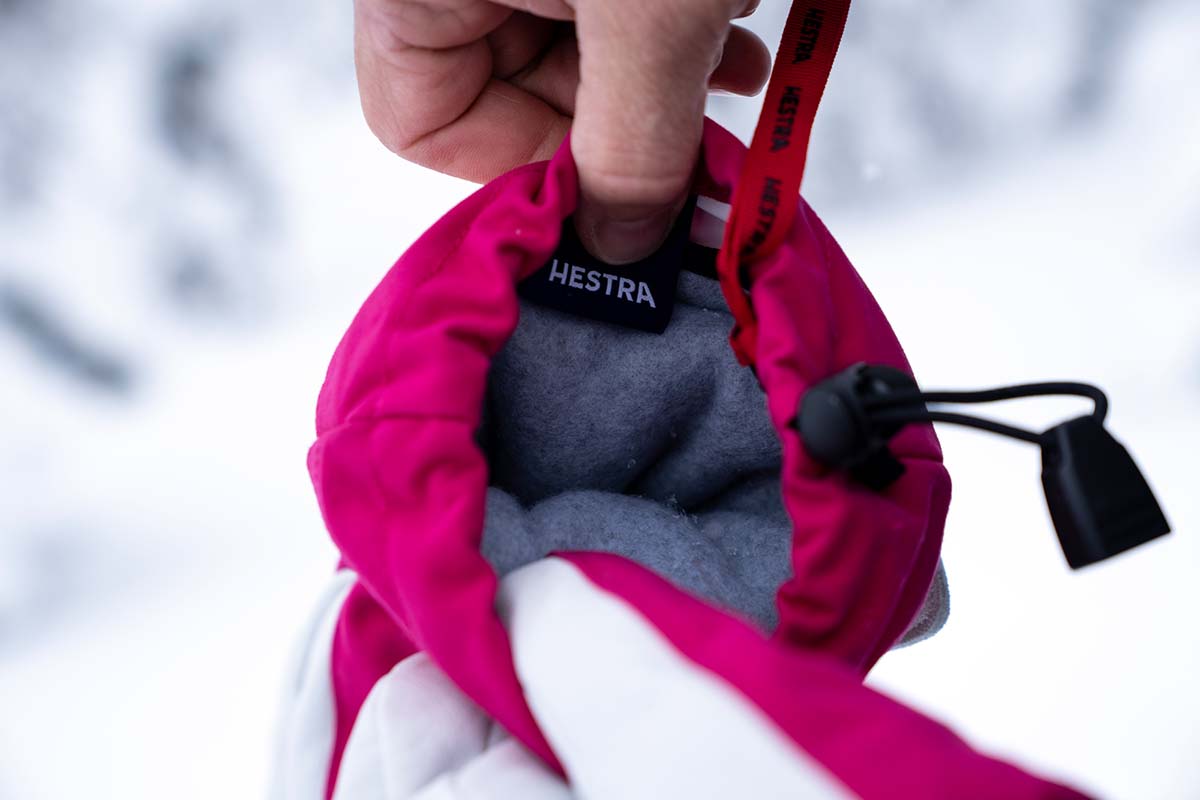
Wool
Wool, and the merino variety in particular, is our favorite material for next-to-skin baselayers and socks, but it isn’t as popular among winter mittens. It’s true that some mittens use wool—including the L.L. Bean Buckskin Chopper Mitt (above) and the snowboard-specific Dakine Phoenix (not listed)—but it has its fair share of drawbacks. Wool generally has a shorter lifespan than fleece and synthetic materials, doesn’t dry as quickly, and can be a bit heavier and bulkier. But there’s no denying its warmth—we like wool for a lightweight liner (worn under a mitten) or for casual use in dry conditions.
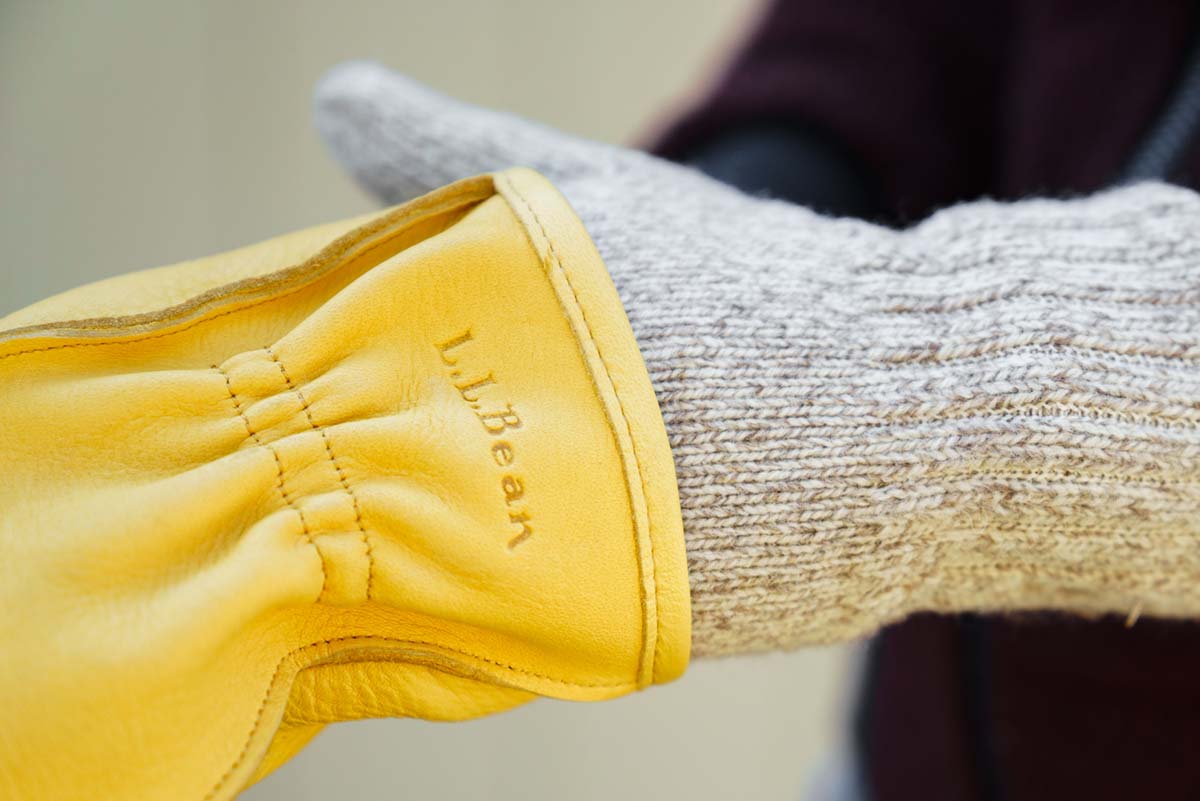
Down
Among insulation options, down is the one you’ll see the least. The main reason is that down must be lofty in order to insulate (read: less dexterity), and natural goose or duck plumage loses its ability to insulate when wet. You can mitigate this issue with a burly, waterproof shell, but even the sweat from your hands can compromise the down fill. As such, you’ll run across the occasional casual down piece like the Outdoor Research Coldfront Down Mitts or Stormbound Sensor Mitts, but synthetic mittens are far more practical (and affordable) for wet and snowy conditions.
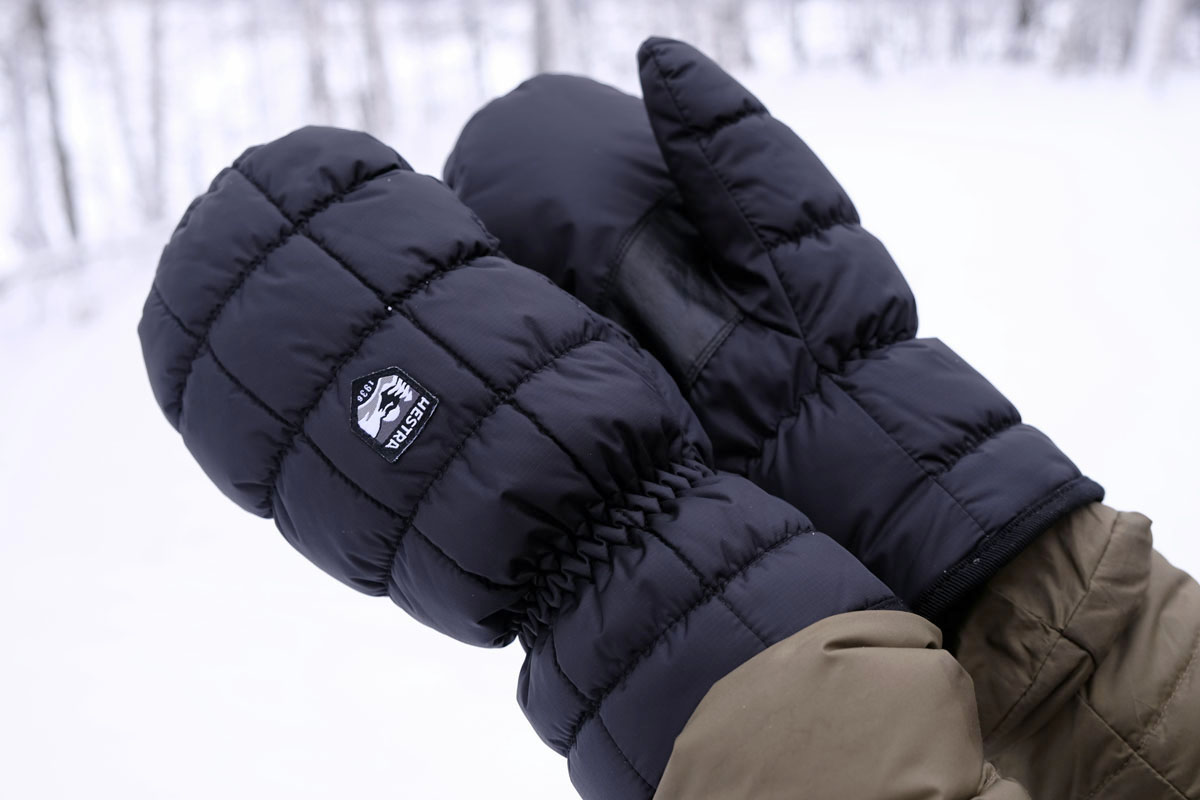
Like rain jackets and hardshells, waterproof mittens feature a waterproof/breathable membrane that prohibits outside moisture (rain and snow) from penetrating while allowing inside moisture (sweat) to escape. Gore-Tex membranes (seen in designs like the Outdoor Research Alti II GTX and Carbide Sensor) are by far the best performing, while in-house efforts (like those used in the Give’r Frontier) can be hit or miss in terms of waterproofing, breathability, or both. For winter—i.e., below-freezing—use, off-brand membranes generally get the job done; but for mild conditions (temperatures around 30 degrees F and above) and serious activities like mountaineering, ice climbing, and backcountry skiing, we recommend a reliable waterproof mitten.
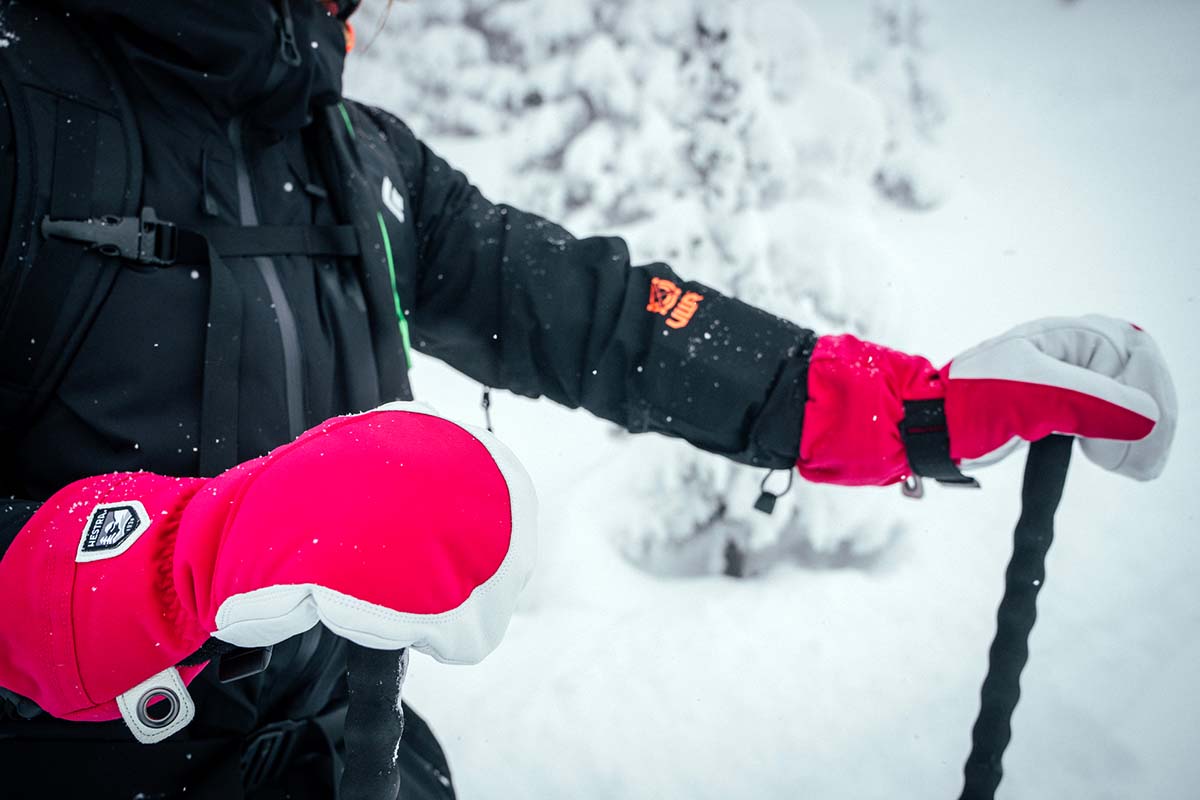
Leather provides the best alternative to a waterproof membrane. It’s naturally water-resistant—not waterproof—but can become fairly impenetrable to moisture with the application of hydrophobic wax (like those from Sno-Seal or Nikwax). That said, if you’re using your mittens a lot in wet conditions, you’ll really need to stay on top of maintenance—without routine wax application, leather will absorb moisture (and if you’ve ever dealt with a wet-then-frozen leather mitten, you know this is a recipe for disaster). But in dry climates like the Rockies, leather can make a lot of sense: Not only is it water-resistant and breathable, but it’s also more durable and dextrous than most synthetic materials.
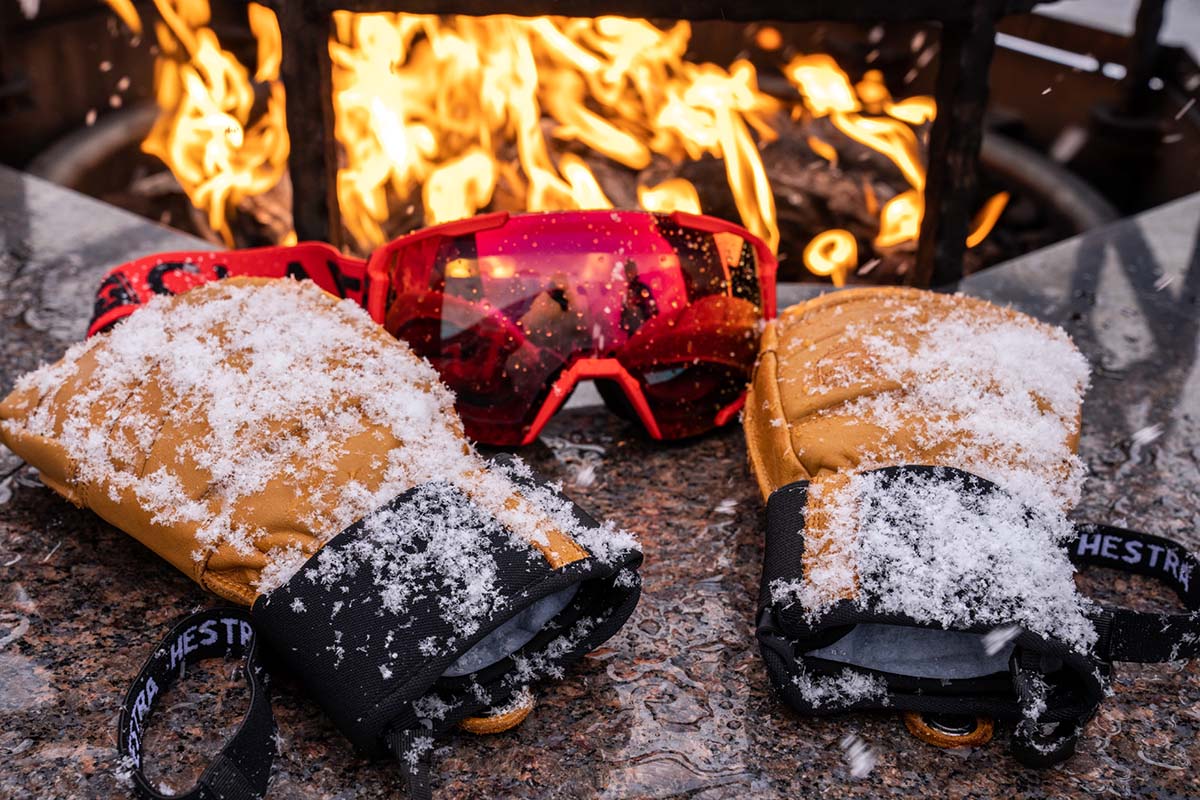
As we just mentioned, leather mittens require occasional treatment to maintain moisture resistance. Some models come pre-treated, while others are DIY after purchase. The most common and effective leather coating is Sno-Seal: This beeswax-based solution requires a fair amount of effort—including baking the glove in the oven—but it’s a proven formula that’s popular among skiers in wet climates. A simpler and less involved alternative is Nikwax’s Waterproofing Wax, which doesn't require heat to activate. Depending on how often you wear your mittens and in what kind of conditions, you may need to re-treat the leather one or more times a winter—it’ll be clear when you need to reapply because the mittens will stop shedding moisture.
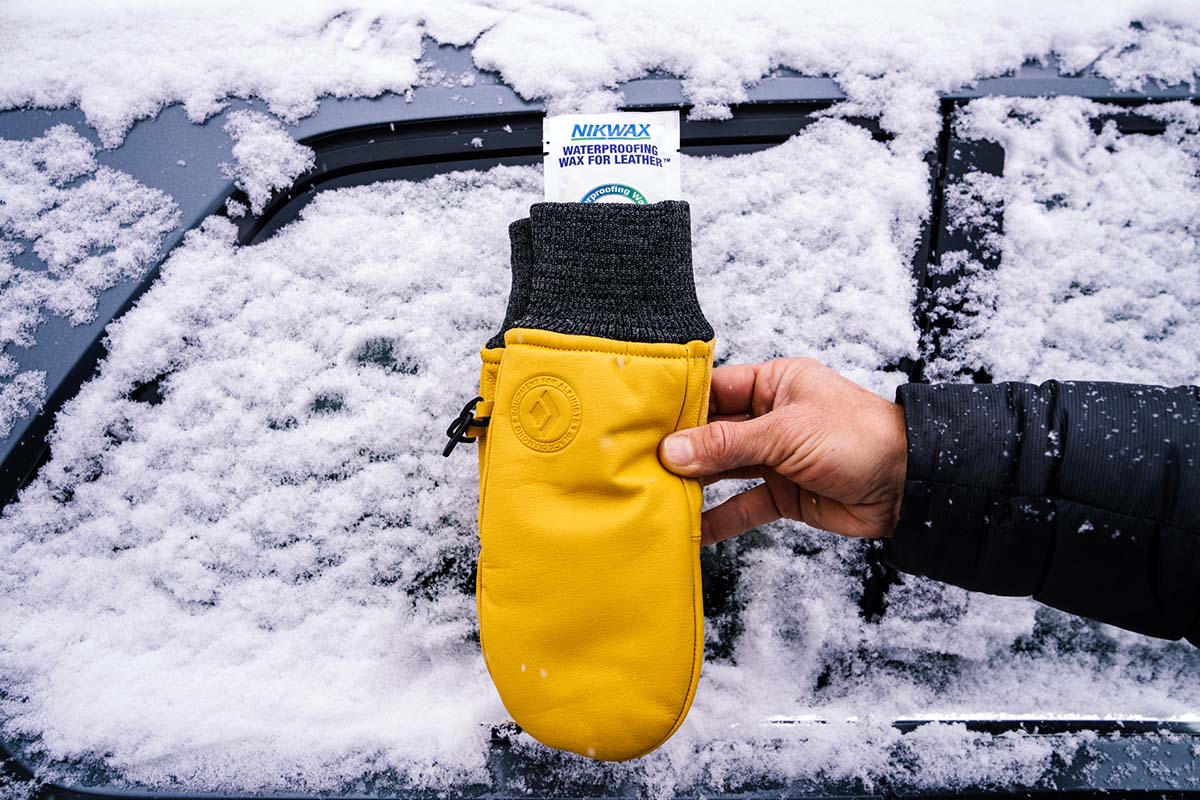
Durability should not be overlooked when it comes to choosing the right mitten. After all, what gets more use than our hands? Leather mittens are generally the most long-lasting choice, and adding a waterproofing treatment like Nikwax Waterproofing Wax or Sno-Seal also can help to extend the lifespan. The majority of mittens with nylon shells are impressively durable, too, and particularly burly and well-made performance designs like the Outdoor Research Alti II Mitts. Generally, insulated designs that aren’t waterproof, such as the Patagonia Nano Puff Mitts, are the most prone to developing holes and tears.
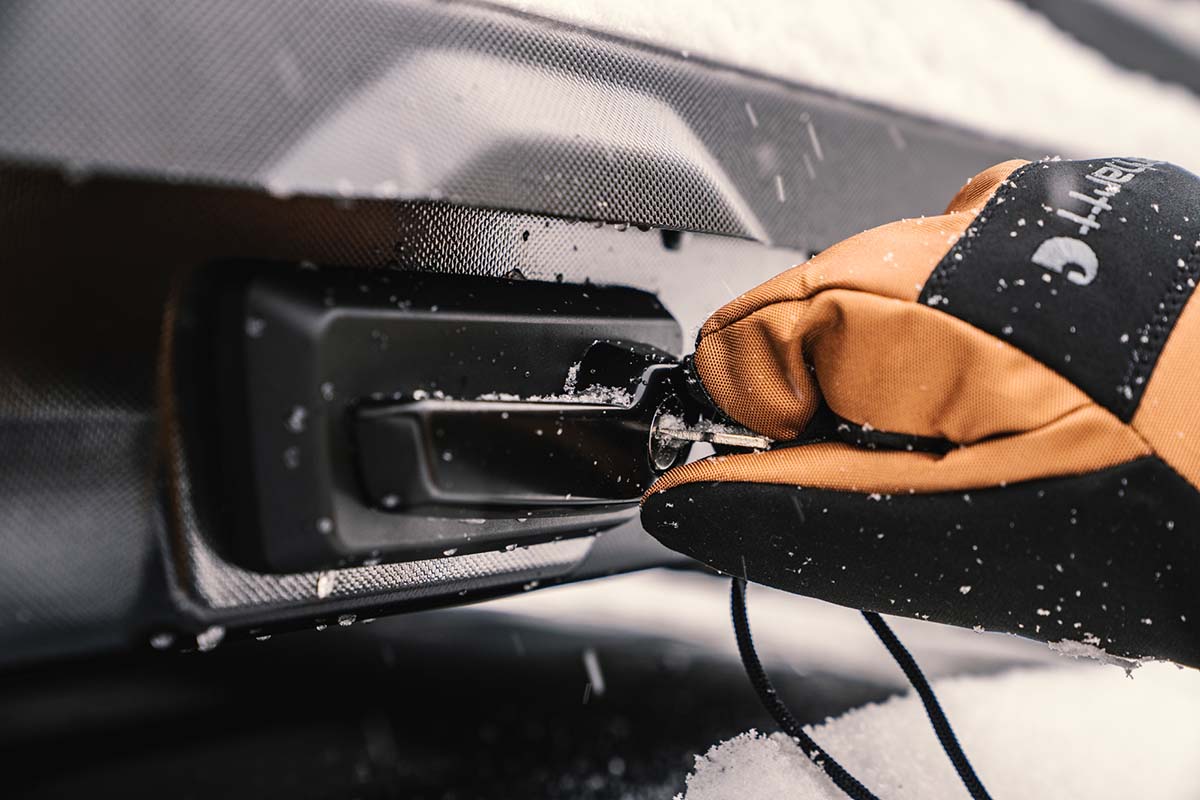
Quite obviously, mittens do not excel in terms of dexterity, and are far from our first choice for activities where we need use of our fingers. But don’t count them out completely: Many models are perfectly serviceable for gripping items, whether it’s a snow shovel, ski pole, steering wheel, or chairlift. If this sort of dexterity is a priority for you, you’ll want to look for a mitten with light to medium insulation, and trust that leather varieties will grow nicely supple over time. The construction also plays a role—mittens with sleek and thoughtfully placed seams make fine motor movements easier. And keep in mind that dexterity doesn’t need to be the top consideration for everyone—thick or bulky mittens can still be useful in many situations, including staying warm at basecamp or walking in extreme cold.
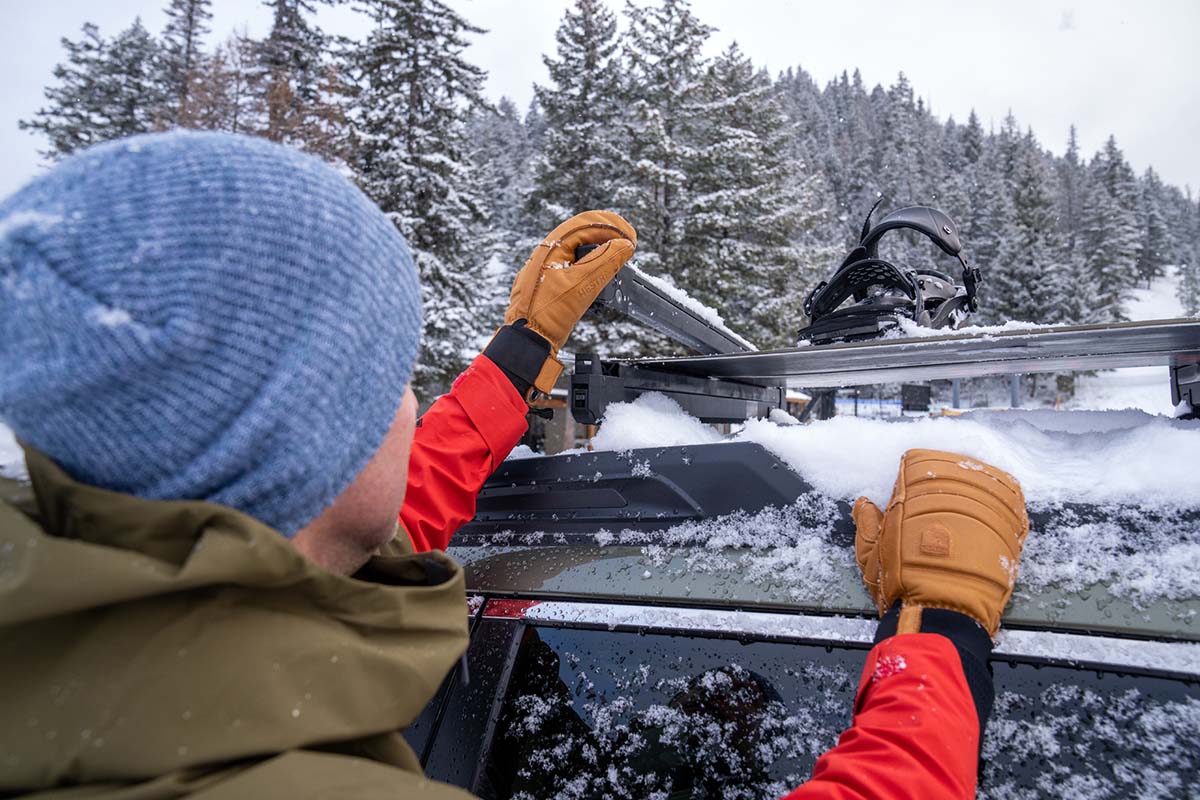
Gauntlet
Gauntlet mittens, like the Hestra Heli or Black Diamond Waterproof Overmitts, extend over the cuff of a jacket (rather than under) and seal with an elastic cinch. When done right, this effectively keeps out cold air and virtually eliminates the possibility for snow to enter. Gauntlet mittens are also easy to get on and off, with large openings and one-handed drawcords that tighten and release. On the flipside, they are often heavier, bulkier, less agile, and less ventilated than other styles, but worth it if you really want to batten down the hatches. We like the gauntlet style best as high-performance mittens for winter sports and expeditions.
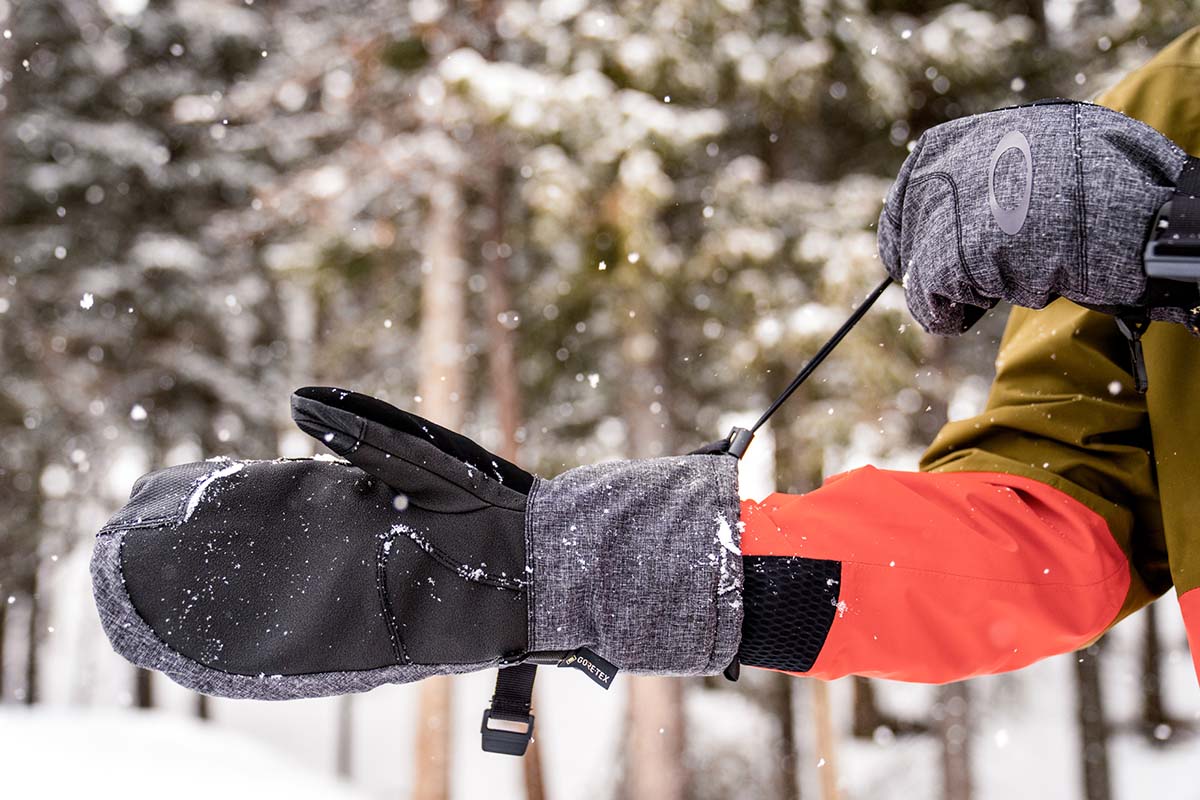
Undercuff
Undercuff mittens—usually incorporating a cuff made with stretchy wool or synthetic material—sit under the winter jacket sleeve and hold the mitten close to the wrist. The cuff provides both a barrier from the elements and keeps the glove from slipping off the hand. While an undercuff mitten is less bulky, lighter weight, and better at ventilating than a gauntlet style, it can’t compete in terms of weather protection. Even if you tighten your jacket sleeves snugly over the top, there’s a chance they’ll ride up during activity. But for outdoor work or everyday use, the simplicity of an undercuff design is very appealing.
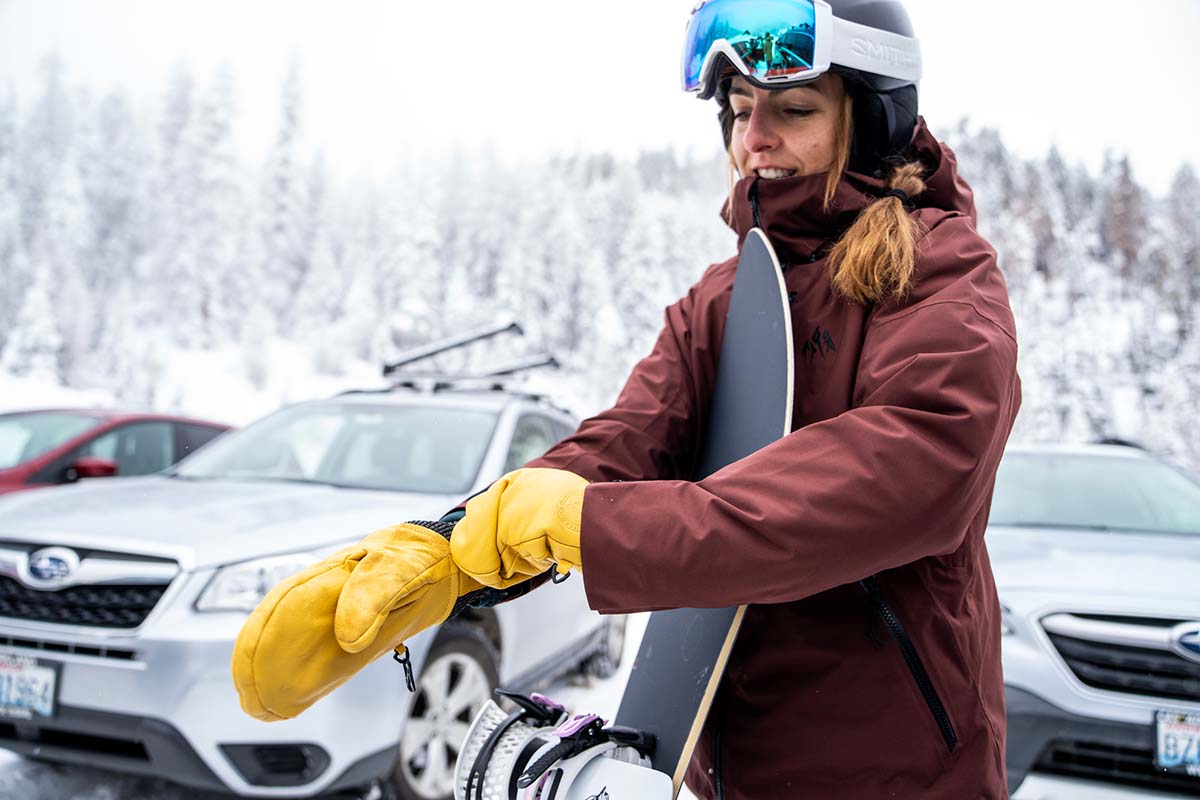
Many mittens—especially those in our performance category—come with either a built-in or removable liner. This liner is generally made from fleece and or sleek synthetic insulation and serves to add warmth and wick moisture away from the skin. We like removable (rather than built-in) liners for their added versatility—you can wear the liner or shell separately, or combine them for maximum warmth—and they’re simple to dry or launder between activities, too. Some cheaper varieties can be fairly clunky in practice—most attach to the shell with strips of Velcro, which makes them more difficult to separate than you’d assume—but premium designs like those of Hestra's Fall Line Mitt are incredibly simple to slip in and out. Liner mittens are the warmest option (and you can even pair them with a separate liner glove), but we do appreciate the dexterity of a liner glove.
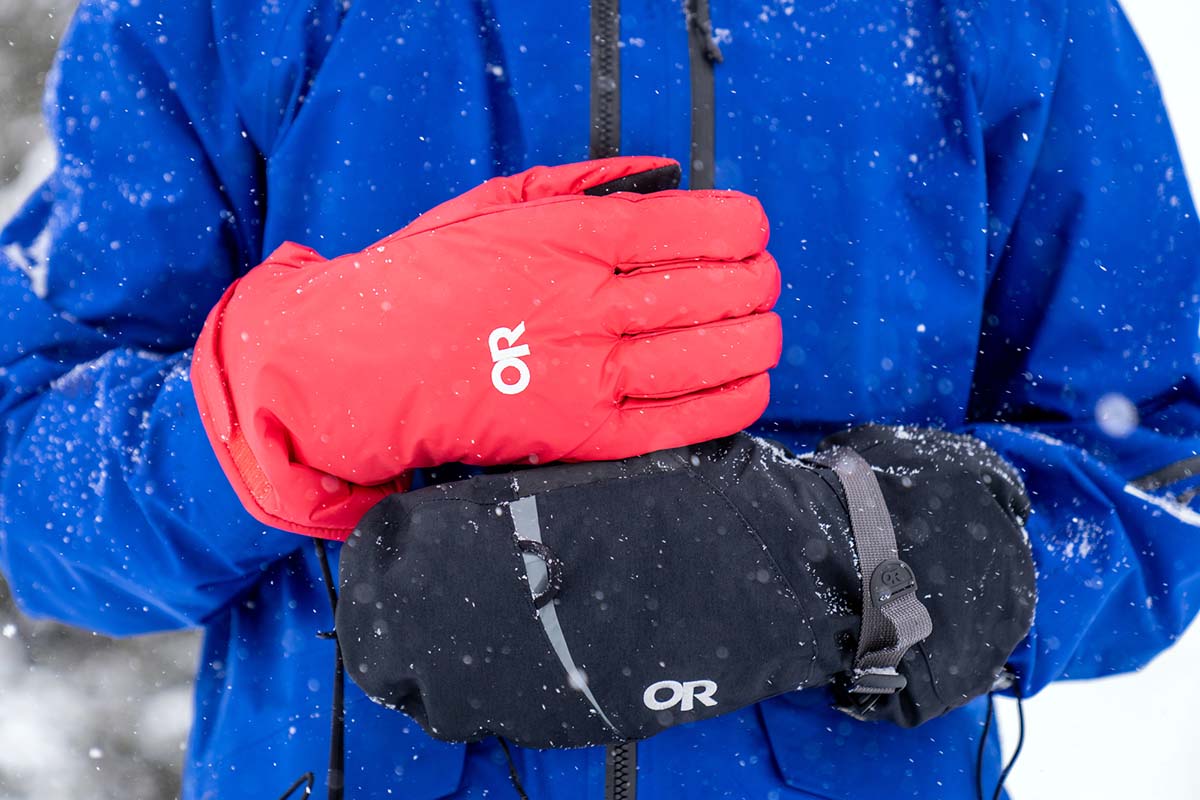
By nature of their design, most mittens are completely useless for operating a smartphone. Outdoor Research advertises their Carbide Sensor Mitts as touchscreen-compatible, but we have yet to have our phone screen respond to any part of the mitten. On the other hand, the Arc’teryx Venta—one of the thinnest designs here—does offer decent performance, although accuracy is limited. The best solution for a mitten is to incorporate a touchscreen-compatible liner glove, which can perform decently well. We’re surprised we don’t see this more: Not one mitten on our list above features a liner glove with touchscreen-compatible tips—not even the premium Hestras. In short, if you’re looking for handwear that you can use to operate your phone, you’ll want a glove.
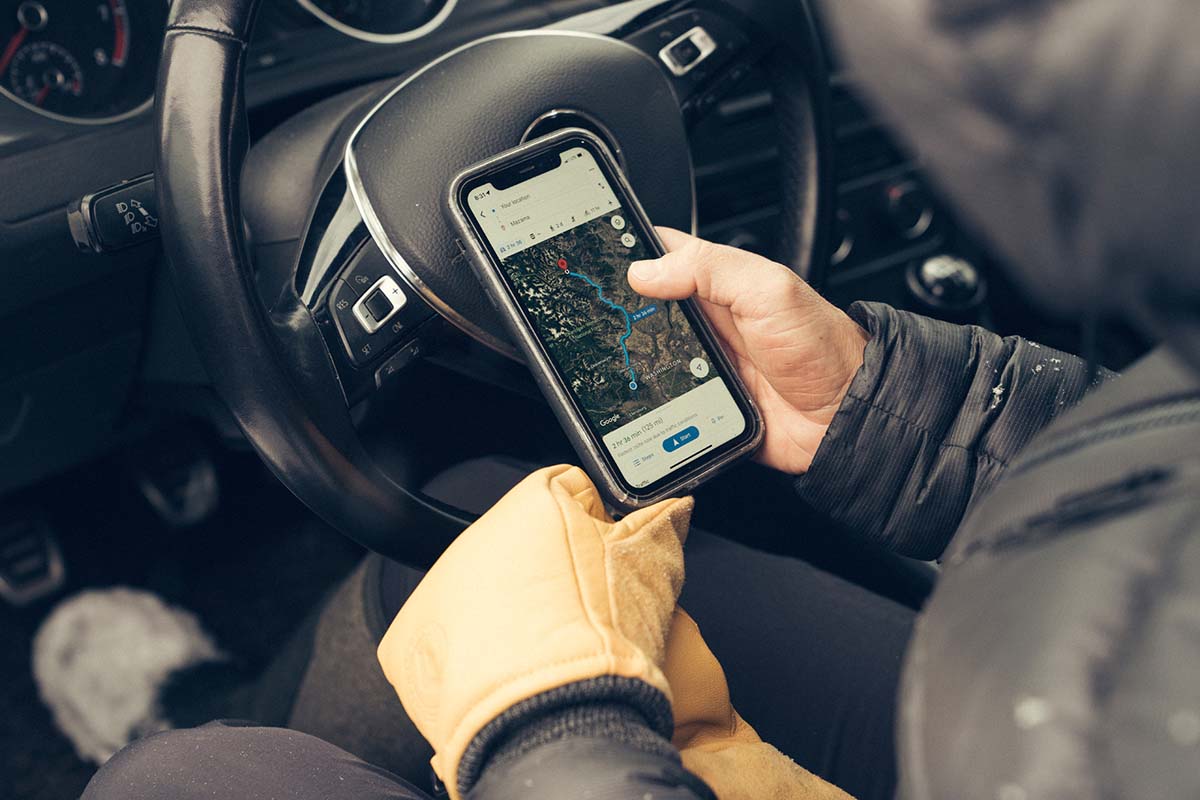
Winter mittens can range from simple leather designs like the Kinco to fully featured models with wrist cinches, nose wipes, zippered pockets, and carabiner loops for carrying on a harness. These features generally increase with performance—everyday and work gloves are usually the simplest, while winter sports gloves often include all the bells and whistles. Some gloves even come with a battery-powered heat pack for particularly cold environments—or particularly cold hands (the Chaval SuperNova Heated Mitt being our favorite).
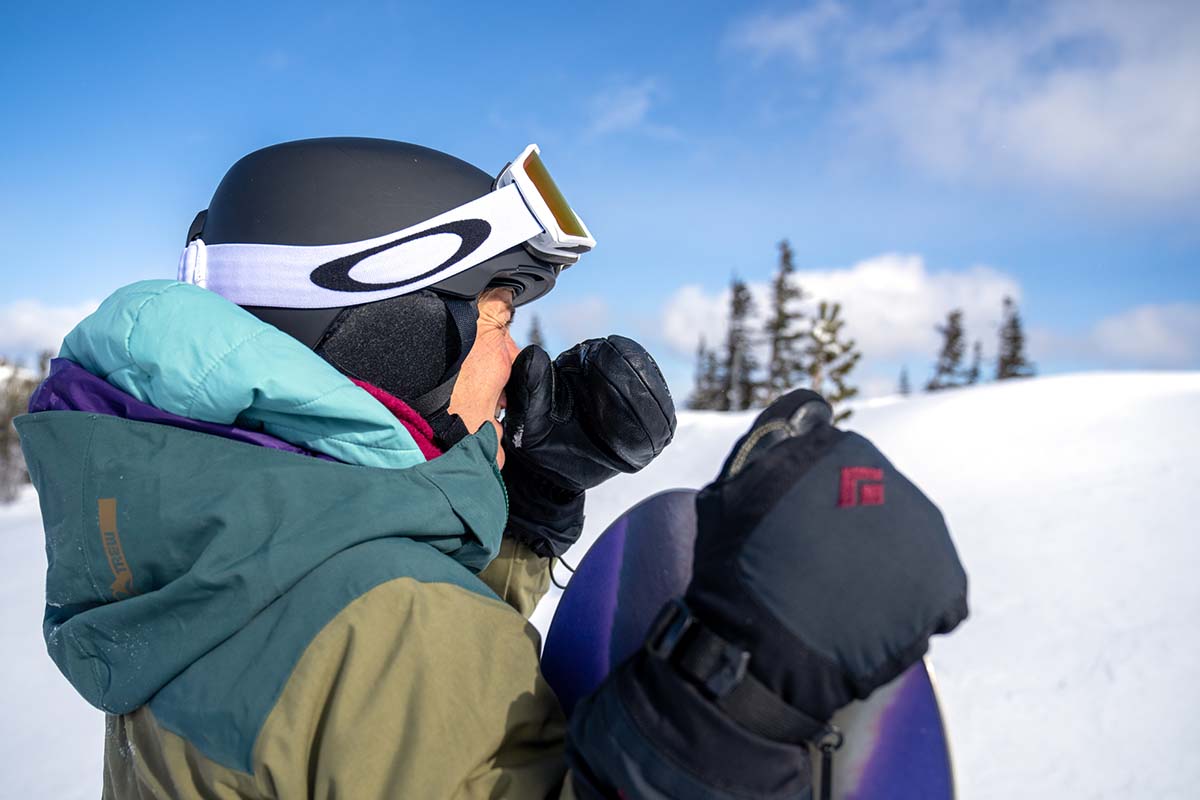
Mittens are far and away the warmest handwear choice, but their lack of dexterity can be a dealbreaker for many. You’ll have to ask yourself what’s worse: the diminished warmth of a glove, or exposing your hands to the cold when your mitten is too clunky to get the job done, whether it’s adjusting a ski boot, unzipping a pocket, or fine-tuning your ski backpack. The good news is, many modern gloves provide ample warmth for most environments, and keeping your body heat high (and staying hydrated) can go a long way towards ensuring warm hands. But in extreme environments like northern Canada, Alaska, the Arctic, and Antarctica, there’s no substitute for a warm winter mitten.
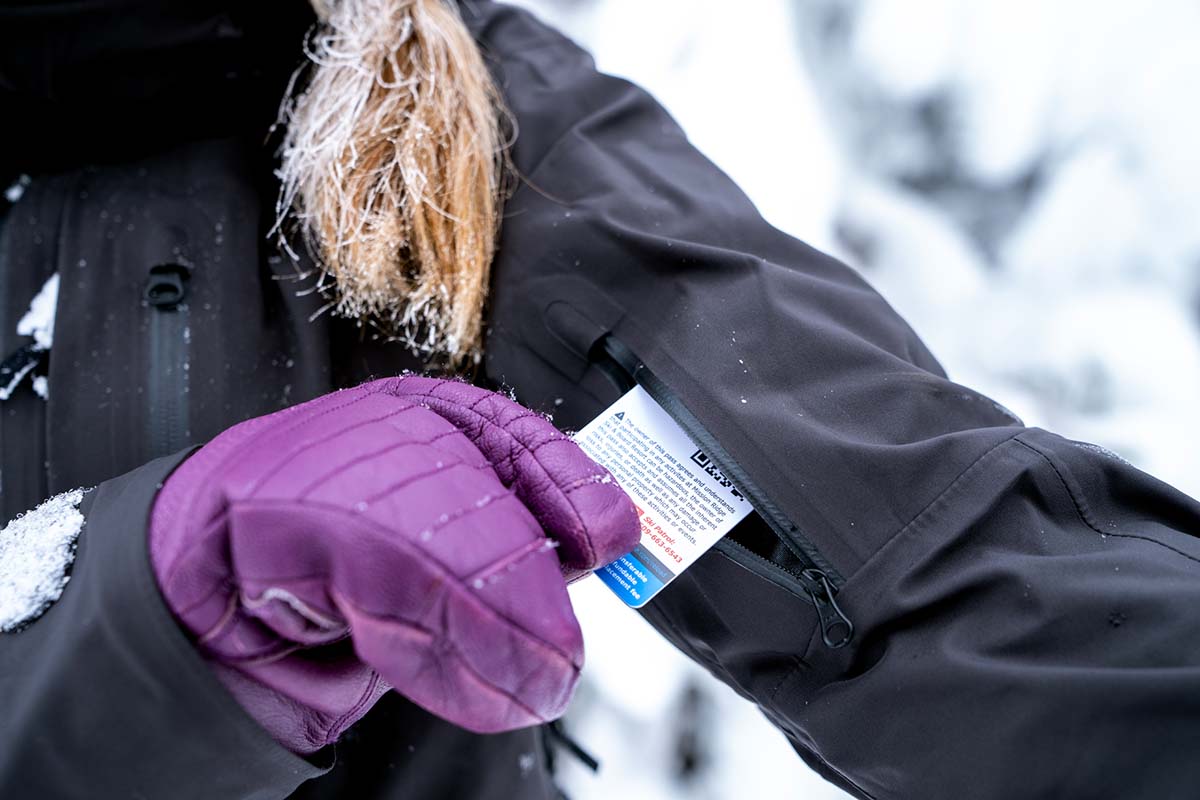
There are a few ‘tweener styles that might offer a best-of-both-worlds scenario for some. First are trigger mitts, also known as lobster or 3-finger mittens (the Oyuki Pep GTX Trigger Mitt is one of our favorites). These mittens separate the thumb and forefinger and group the latter three fingers together, offering most of the warmth of a mitten without the drop in dexterity. Second are gloves with mitten flaps, which can come in the form of a high-performance offering like the Black Diamond Cirque, or the age-old, wool glommit design. The partial flap will not suffice to keep your hands dry in snow or rain, but in dry climates these designs serve to offer convenience, dexterity, and warmth all in one.
Back to Our Top Winter Mitten Picks Back to Our Winter Mitten Comparison Table